4 Days in San Francisco: Perfect Itinerary for First Timers
Ah, San Francisco. San Francisco holds a special place in both of our hearts.
First of all, we met in San Francisco, which should probably count for something.
But beyond that, many of the milestones in our growth – both as individuals and as a couple – took place in the City by the Bay.
We went on our first date in San Francisco (our first three dates were great – a picnic at Dolores Park, a SF Giants game, and a boozy minigolf session).
We moved in together in San Francisco. We got married in San Francisco.
And we decided to quit our jobs to travel the world together in San Francisco (in 2020 – bad timing on that one, but it all worked out in the end!).
We don’t live in San Francisco anymore (it’s expensive, y’all – too expensive for self-employed travel writers, anyway), but we spent just shy of a decade exploring the city and the surrounding area in Northern California together.
We’ve done everything that we recommend below in this itinerary, and plenty more. We’re as close to experts as it gets without having grown up in the city.
We’re here to help you plan an incredible trip to San Francisco, and we’ve written this detailed guide for a four day trip, though we have plenty of ideas (read: strong opinions) about spending more and less time in the city.
With that preamble out of the way, let’s talk about what you’re going to find in this guide.
In this guide to planning your trip to San Francisco, you’ll find a detailed 4 day San Francisco itinerary, complete with things to do, see, eat, and drink, along with the important details you need to know like how to see Alcatraz and the best views of the Golden Gate Bridge.
You’ll also find logistics – like how to get around and some useful tips and tricks for visiting San Francisco – that are important for planning your trip.
We hope you enjoy this guide, that you find it helpful for planning your trip, and we help you discover something new and exciting, whether it’s your first time, or tenth.
Sound good to you? Let’s get into it.
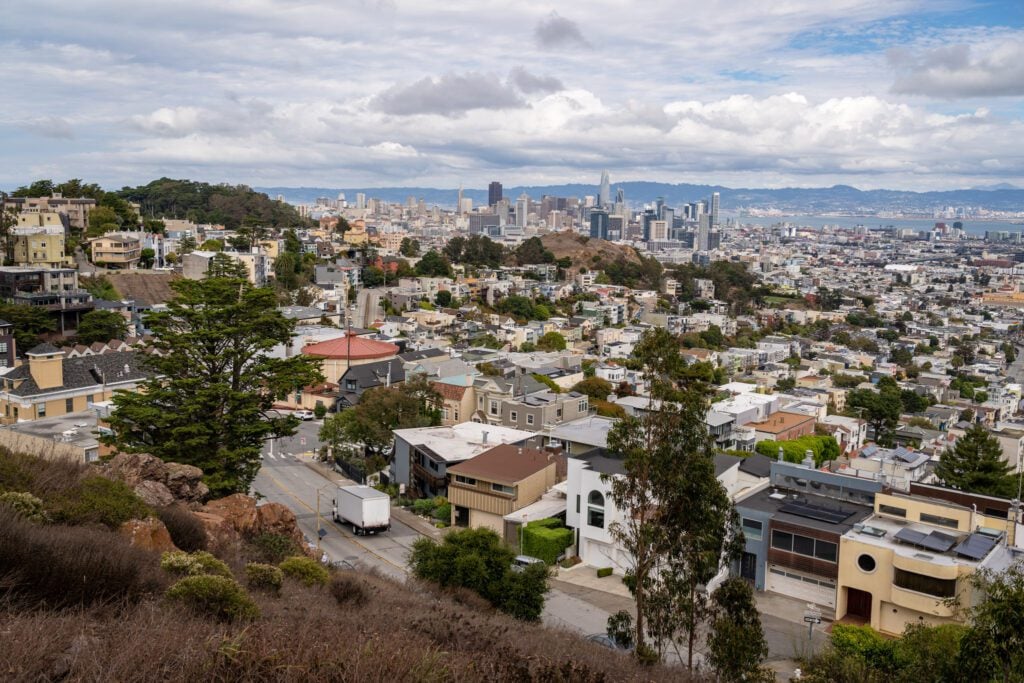
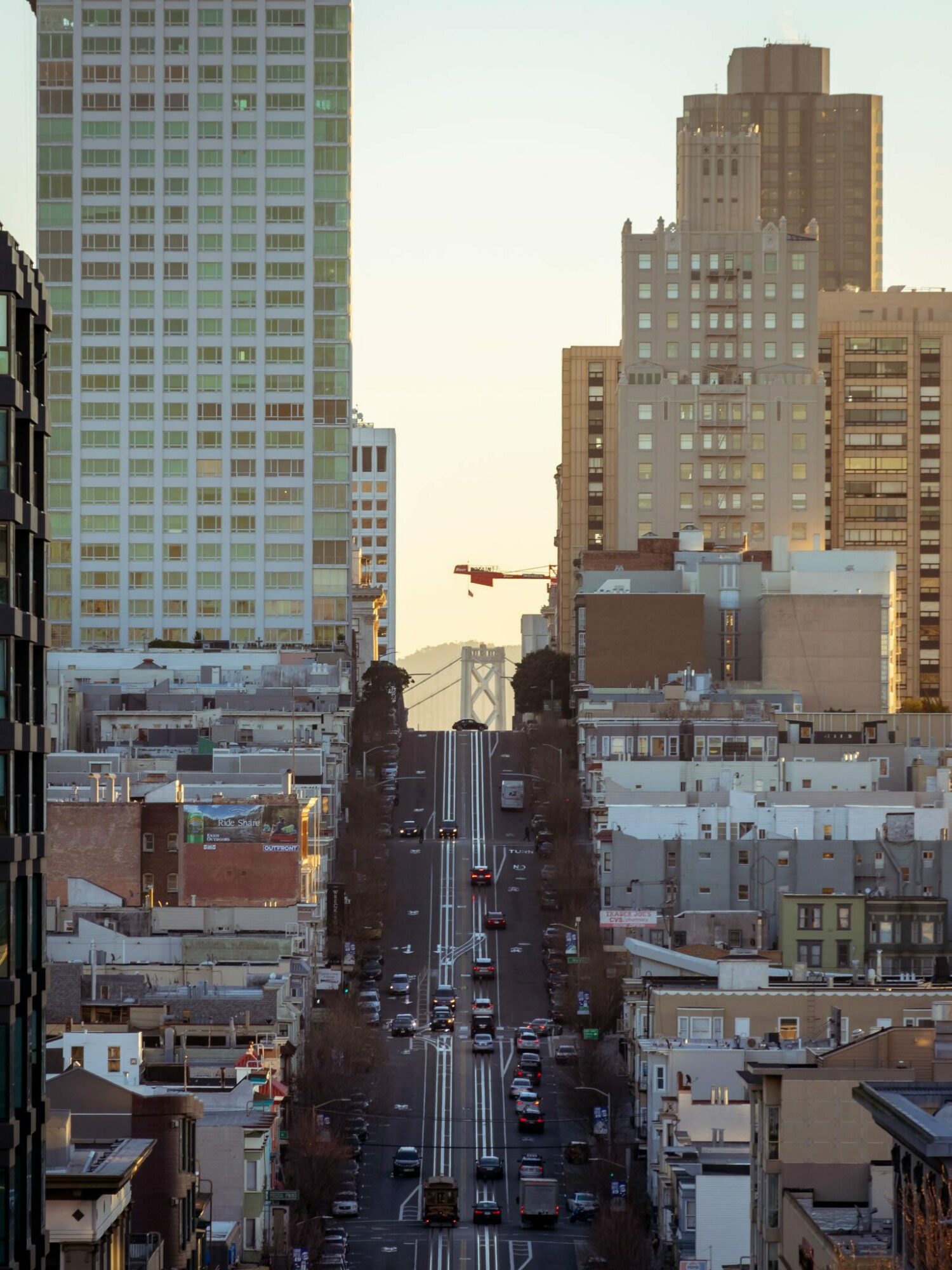
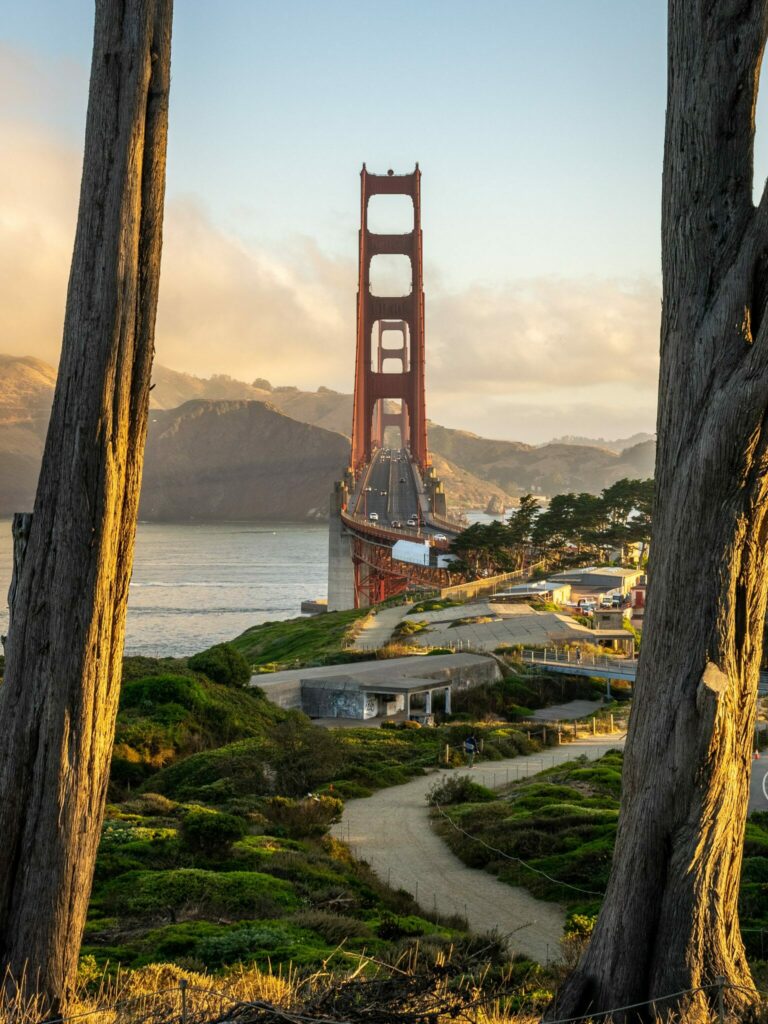
Disclaimer: Some of the links in this post, like hotel links, are affiliate links, meaning at no additional cost to you, we make a little bit of money if you click through and book. That being said, we would never recommend something to you that we don’t stand behind 100%.
What Can You See with 4 Days?
Look, we spent just under a decade exploring San Francisco together, and we still have places that we haven’t quite made it to. It’s a big city with tons to do and see, and you won’t be able to tackle it all on your first or second trip.
However, four days gives you a nice amount of time to dip your toes in and immerse yourself in the city to see what makes it special and captures the hearts of so many visitors.
There will certainly be things, bars, restaurants, and places that you’ll have to save for your next trip (which you’ll probably already be planning on the trip home).
With four days, we think you should spend three days in the city itself, exploring vibrant neighborhoods, experiencing San Francisco’s amazing food scene, and doing some exploring on foot.
On the last day, get out of the city on a day trip to explore one of the many cool areas within an hour of the center of the city. We’ll give you three options to choose from, depending on what you’re into.
Over the course of your time in the city, you’ll have time to do a mix of the main tourist attractions – things like the Golden Gate Bridge, Golden Gate Park, Alcatraz, and the Ferry Building – while also saving some time to explore some of our favorite neighborhoods in San Francisco.
If you happen to have more or less time, we have ideas on what to add or subtract in the sections below the main itinerary.
Where to Stay in San Francisco
Since you have 4 days, you don’t need to be too concerned about staying somewhere super central so you can cram all of the tourist attractions in – you’ve got the gift of time!
For a longer trip (4-5 days), we’d recommend staying in one of two neighborhoods: Nob Hill (our former home!) or Union Square. We have a mini overview of each, complete with some cool places to stay, below.
We have an entire guide breaking down the best places to stay in San Francisco with plenty of detail that won’t fit into this relatively small piece of this guide, which you should read if you’re trying to decide where to stay.
If you’re coming to SF with a car, we’d recommend staying in the Marina at the Star Motel and the Coventry Motor Inn, two motel-style places to stay where parking is included (which will save you anywhere from $30-80 a day in parking fees).
It’s not the most convenient place to stay (though it is close to the Golden Gate Bridge!), but the savings in parking are worth the tradeoff we think.
Staying in Nob Hill: Charming, Central, and Beautiful
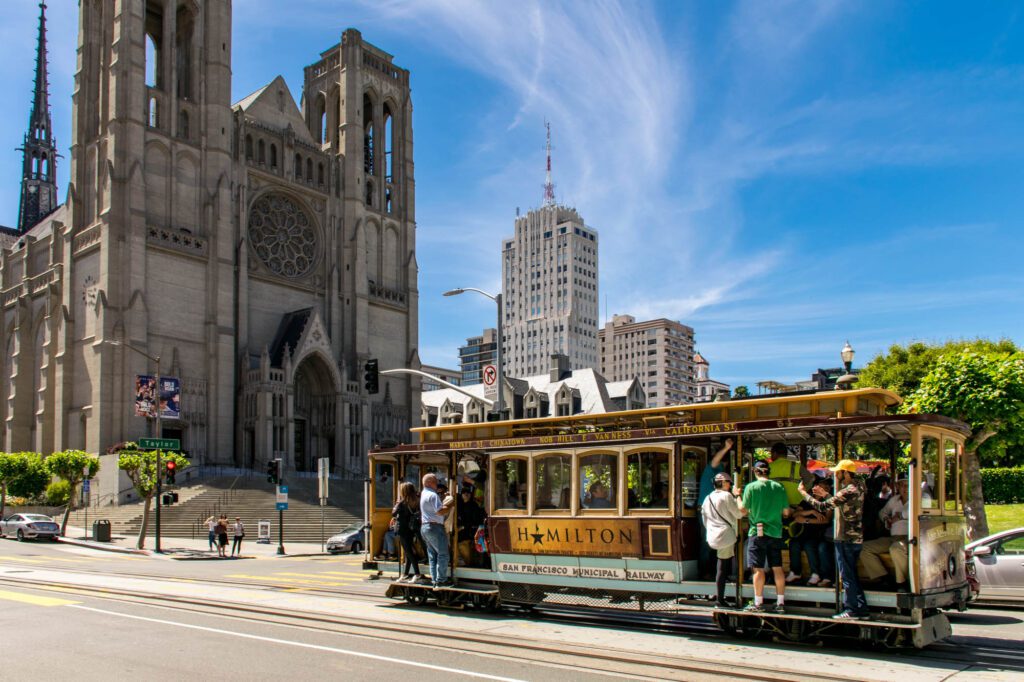
Nob Hill is where we lived for our last three years in San Francisco. It’s leafy, charming, and super central, which is why we love it.
There’s tons of good food and drink options along Polk Street, and a walk down the hill to the north takes you into North Beach, the historically Italian stronghold in San Francisco that is one of the best neighborhoods to explore on foot (but I wouldn’t recommend you stay there).
Petite Auberge: After we moved out of the city, we decided to do a quick staycation and return to our old stomping grounds in Nob Hill. We chose Petite Auberge because, along with the sister hotel next door – the White Swan Inn – it feels like the most charming hotel in the area.
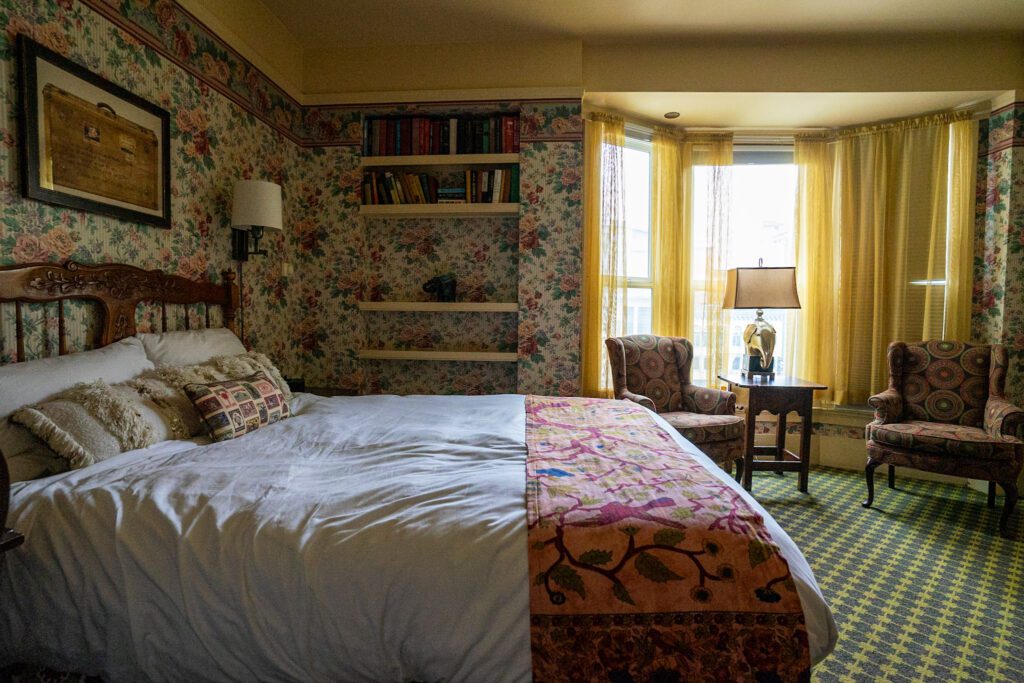
In fact, it’s much closer to a bed & breakfast than a hotel. They describe it as part bed & breakfast, part boutique hotel, which seems accurate based on our experience.
The rooms are very French-feeling, with floral print wallpaper and wooden furniture. Some rooms have a fireplace, which we very much enjoyed.
White Swan Inn: The Sister Hotel to Petite Auberge, it’s just a few doors down and has many of the same characteristics. Except the theme here is the English countryside, and you’ll find tartan patterns instead of flowery wallpaper.
Stanford Court Hotel: Both of us have passed by this boutique hotel in Nob Hill – which has recently been renovated – countless times on our way to and from work (often on the cable car, which is without a doubt the best commute ever).
It’s in a great location, especially if you’re in San Francisco for work because of its proximity to the Financial District, and it would make a great home base for a visit to the city.
Union Square: The Most Convenient Place to Stay
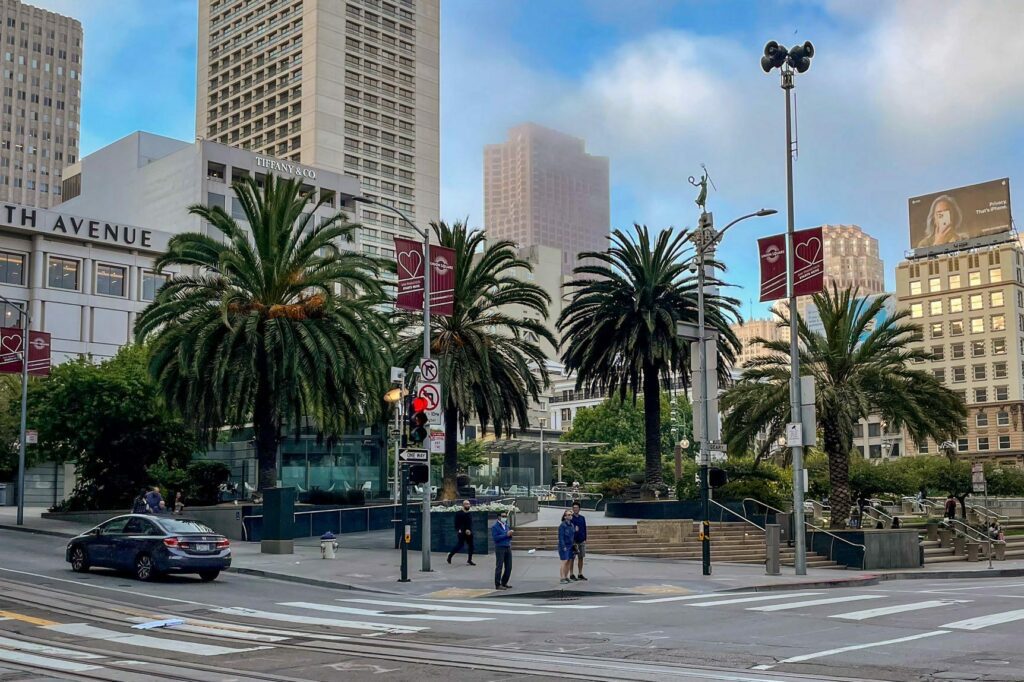
Look, Union Square is not the sexiest neighborhood in San Francisco. It’s probably not even in the top 10.
It’s touristy, packed with chain retailers and skyscrapers, and is essentially missing every bit of charm that has made us, and many people like us, fall in love with San Francisco over the years.
However, it DOES have the best selection of hotels in the city. And it’s not close.
We’d make sure to stay on the side of the neighborhood towards the Financial District (which is to the east) because the neighborhood immediately to the west isn’t great.
If you look at the pros and cons list for Union Square (which, by the way, you can find in our guide to the best areas to stay in SF), it basically comes down to “it’s well-connected and central with tons of hotels, but it kind of sucks so plan on exploring elsewhere.”
CitizenM Union Square: We love CitizenM hotels, and this hotel in the heart of Union Square is almost exactly the same as their other hotels around the world (we’ve stayed in three of them in the past few years).
They basically took the entire concept of a luxury hotel, scrapped all preconceived notions (like there has to be a bellhop and a huge soaking tub) and built an affordable boutique hotel from the ground up.
The rooms are meant for sleeping, which means they’re small (even for San Francisco standards), but they have huge comfy king beds, blackout curtains, and soundproofing to make sure you get what you’re paying for – a good night’s sleep.
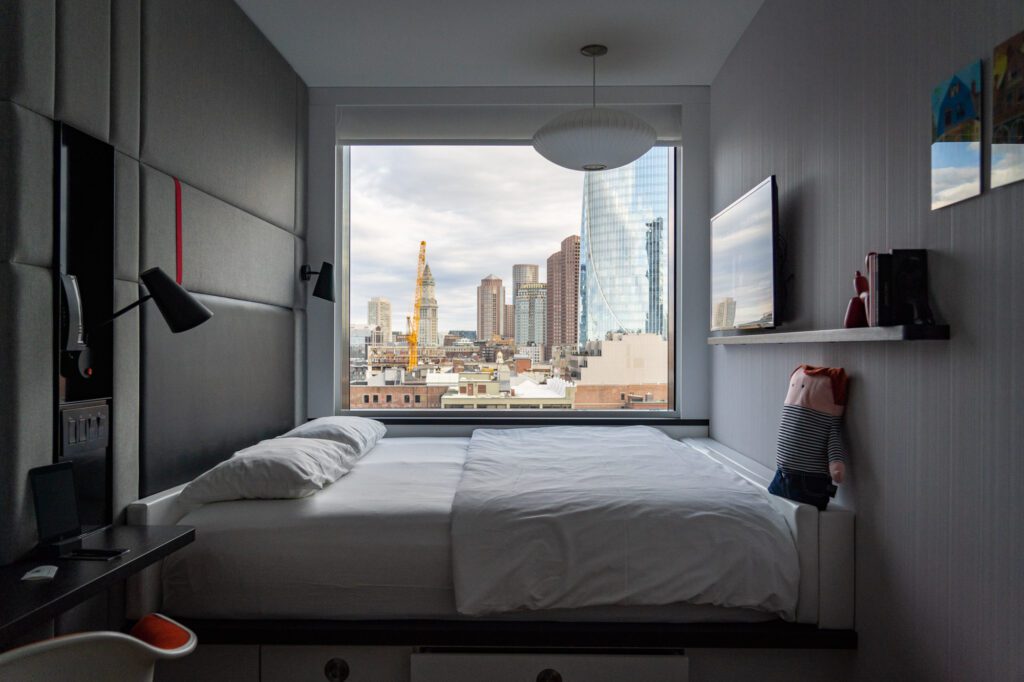
And they’ve shifted the in-room amenities like coffee machines and ironing boards to common areas, so the cost of the room is lower.
For more detail on why exactly, read about our experience staying at the CitizenM Seattle.
On our latest trip to San Francisco this past fall, we stayed at the Orchard Garden Hotel on Bush Street (which is in a location that is right on the border of FiDi, Union Square, and Chinatown) and it was great.

It’s a more business-focused hotel, so you’ll trade amenities like a good onsite bar for quiet rooms and reasonable rates.
It’s not the sexiest hotel we’ve ever stayed at (and it probably needs a facelift), but the service was great, as was the value.
A Perfect 4 Day San Francisco Itinerary for First Timers
Now that we’ve got some important logistics covered, here is how we would spend your time in San Francisco as a first-time visitor.
And, to be clear, the best locals-approved abbreviation for San Francisco is “SF” (“ess-eff”). More tips like that in our guide to visiting San Francisco for the first time.
We’re going to assume that:
- You don’t have a car, so you won’t have to worry about parking or moving it.
- You’ve never been to San Francisco, so you’ll want to see all the “touristy” sights.
- You’re a fan of walking and exploring the best neighborhoods in San Francisco on foot.
Here’s an overview of the 4 day itinerary you’ll find below:
- Day 1: The Ferry Building, North Beach, and Alcatraz at Night
- Day 2: Golden Gate Park, the Lands Ends Trail, and the Golden Gate Bridge at Sunset
- Day 3: NoPa and the Mission District
- Day 4: Choose Your Own Day Trip Adventure (3 Options)
Below the detailed itinerary, you’ll find some suggestions on what to do with more or less time on your trip to San Francisco, including options for compressing this itinerary into one, two, or three days.
What to Book in Advance: In general, there’s not a whole lot of sights in the itinerary below that you’ll need to book in advance.
The exception is Alcatraz. You’ll want to book your visit to Alcatraz several months in advance. It does sell out, and if it’s a must-do for your trip, book 2-3 months in advance.
A couple of weeks or a month in advance, consider booking things like walking tours or cooking classes.
Day 1: The Ferry Building, North Beach, and Alcatraz at Night
Spend your first day on the eastern end of the city, exploring three great neighborhoods (North Beach, Chinatown, and Nob Hill) before ending with an evening trip out to Alcatraz Island.
But First, Coffee
If, like me (Matt, the resident coffee nerd in this corner of the internet), you wake up and are immediately in desperate need of a caffeine boost before you can become a coherent human, you’re in luck!
There are some great options in SF (here’s my guide to my favorite coffee shops in San Francisco).
If you’re downtown, our favorite option is going to be Paper Son Coffee’s location just south of Market, which is great for filter coffee, milk drinks, and specialty seasonal drinks (like their passionfruit espresso tonic).
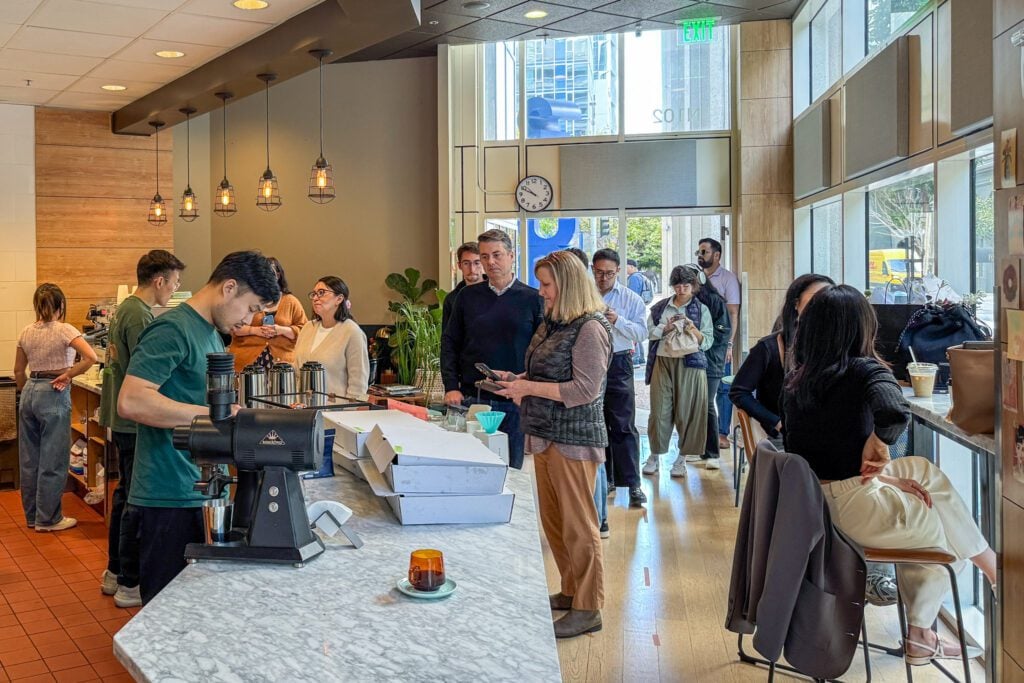
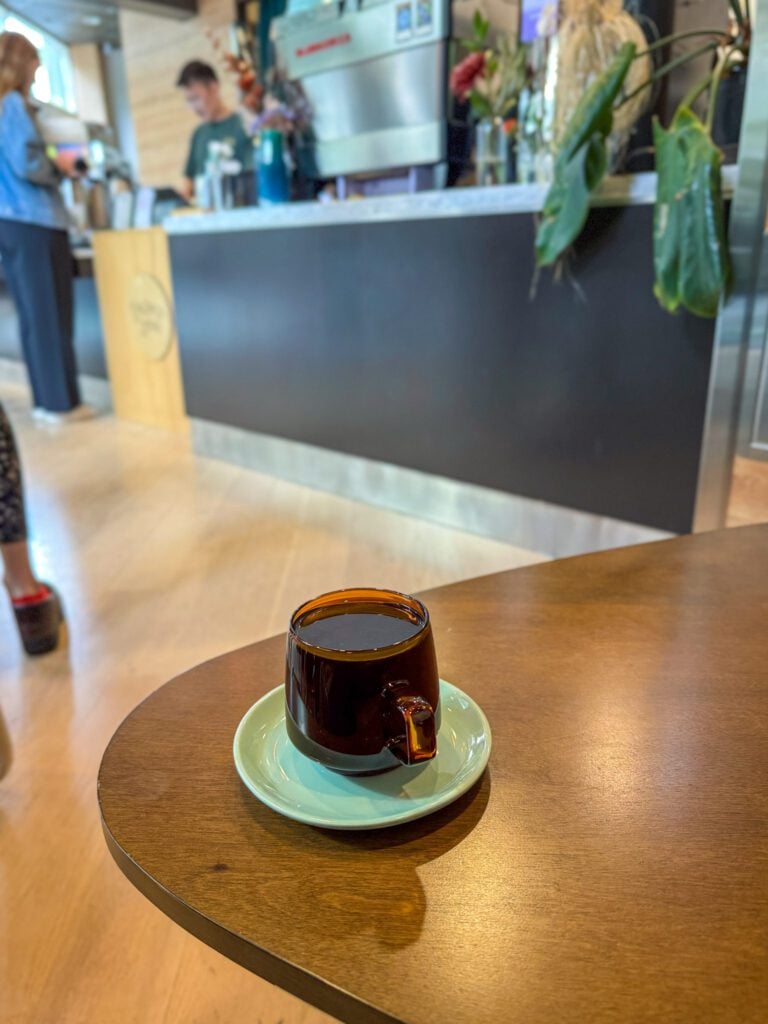

They use a rotation of great roasters, including Hydrangea and Moonwake (two of Matt’s favorite Bay Area roasters).
A close second is going to be the OG multiroaster shop in the city, The Coffee Movement, who were one of the first spots in SF that I can remember bringing in exciting coffees from all over the world.
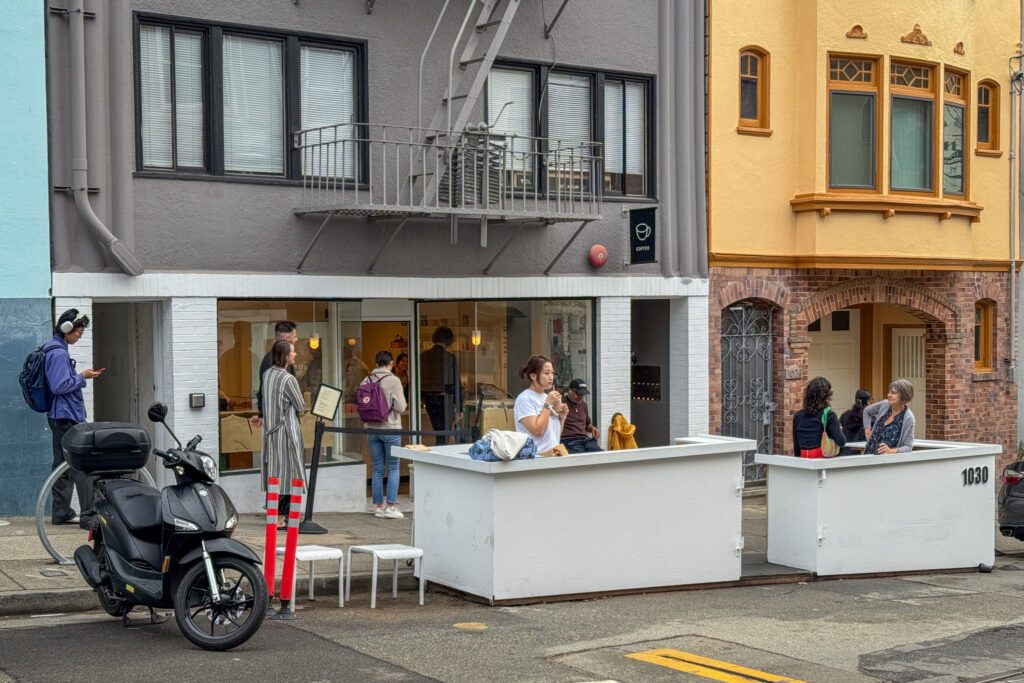


The menu is fairly similar to the previously mentioned option, though the roasters and specialty drinks are going to be a bit different.
If you’re close to Nob Hill, their original location is over on Washington St, a few blocks from where we lived before we left SF.
The Ferry Building
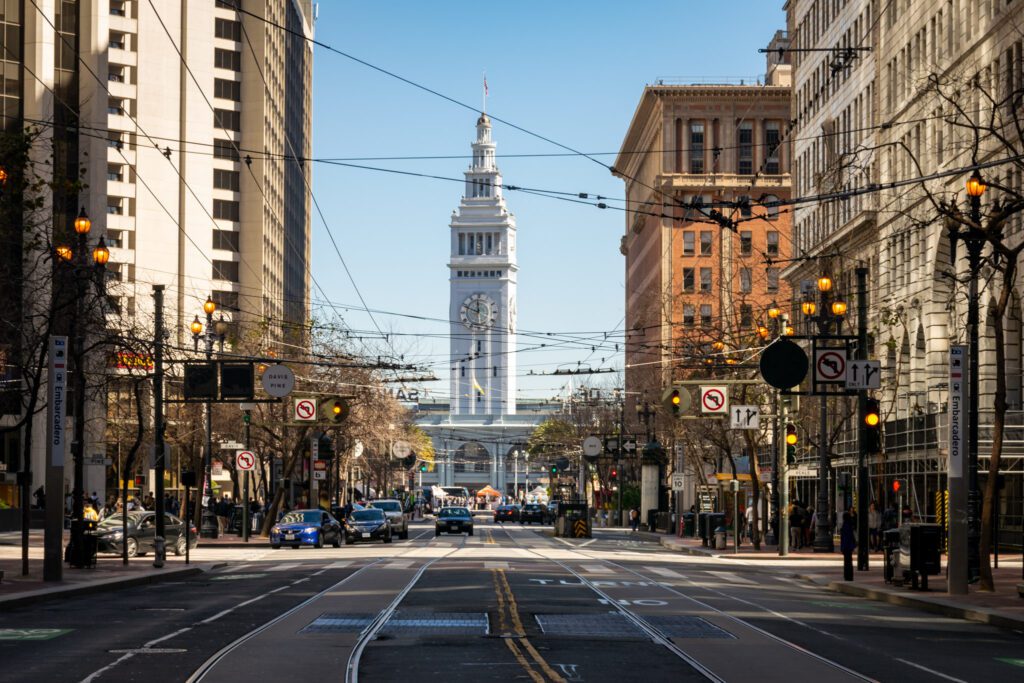
Kick off your trip to San Francisco by heading to one of our favorite spots in the entire city – the Ferry Building.
If you’re lucky enough to be in town on a Saturday, make sure this day falls on Saturday.
There is an awesome farmers market that takes place at the Ferry Building with a combination of farm-fresh produce from all over Northern California and cool local food brands with a variety of ready-made foods. More information here.
There’s also a new “Fog City Flea Market”, which is a makers / vintage market that happens every day (at the time of writing). More information here (you’ll have to find it on the events page).
The Ferry Building is essentially one big collection of various local businesses, each with their own stall or storefront.
Most places here have bigger locations elsewhere in the city, but have a stall here to cater to the thousands of tourists a day who make their way to the Ferry Building.
Here are some of our favorite spots at the Ferry Building.
Blue Bottle Coffee: One of the OG’s of specialty coffee in the world, Blue Bottle has now created a worldwide empire of minimalist coffee shops adorned with their signature blue cup logo. While it’s not my favorite place to get coffee in San Francisco, they make a nice cup of coffee.
Humphry Slocombe: When it comes to ice cream in San Francisco, there are exactly two places that come to mind immediately, and Humphry Slocombe is one of them (spoiler: you’re going to the other one later in the afternoon / evening).
Humphry Slocombe is known for their innovative flavor combinations – my older brother still talks about the original (I think?) “Secret Breakfast” he had a decade ago, which was bourbon ice cream with corn flakes. They have a storefront in the Mission District too.
Mariposa Baking Company: A 100% gluten free bakery! With croissants and baguettes and all sorts of other goodies. Their sandwiches are good too – the California and the Gobbler are Matt’s two favorites.
Dandelion Chocolate: Single-origin craft chocolate made from exactly two ingredients – cocoa butter and sugar. Who knew chocolate could be so fruity?! They also make delicious hot chocolate, and Alysha’s favorite, a chocolate chai. Head over to their cafe on Valencia Street in the Mission District for an even deeper experience, or to their factory in the Mission for a chocolate tour!
Heath Ceramics: We love Heath! So much so that almost all of our dishes at home are Heath now. If you’re a sucker for beautiful ceramics, make sure to stop by their stall at the Ferry Building. Even better, head out to their showroom in SOMA, or their factory over in Sausalito, which has been operating since 1959!
Epicurean Trader: This place has a full storefront in the Marina, which is a great place to buy all kinds of specialty food items (we go for their cider and chocolate selections). It’s expensive, but we like that you can’t find most of the stuff they have in 99% of other stores.
Gott’s Roadside: You’re probably full from brunch, but if you’re hungry and in the mood for a burger, this is the place to go. They have veggie burgers and gluten free buns (though they’re not safe for Celiacs).
Head Up to the Top of Nob Hill

From the Ferry Building, which is at sea level, head up the hill to one of the highest points in the city at the top of Nob Hill.
Now, if you’ve read our SF travel tips for first timers, you’ll already know that the hills are brutal (a fact that Matt forgot and was reminded of when he walked this very hill on his last trip to the city).
Lucky for you, there are two public transportation options that leave from near the Ferry Building that will take you up the hill.
First is the iconic San Francisco Cable Car, which runs up California Street to the top of the hill and leaves from here.
We used to ride the cable cars in San Francisco often to get up and down this exact hill (we lived at the top of Nob Hill) because they are included if you have an unlimited monthly transit pass (which only makes sense for residents).
However, if you’re paying for a cable car ride, you should know ahead of time that it is exorbitantly expensive. It’s a whopping $9 a person (kids under 4 ride free).
Compared to a regular bus ride at $2.85, you’re paying more than triple for the privilege of riding the cable car (which, to be fair, is pretty cool).
The second option is hopping on the bus – specifically the 1 – which runs up Sacramento St, which is one block north of the cable car route.
This is the cheaper, more utilitarian option, and it’s not nearly as charming as the cable car, but will end up at almost the exact same location.
Whichever route you choose, we’d take it up to Powell St and head to the intersection of Powell and California (here on Google Maps), which is one of our favorite views in the city.
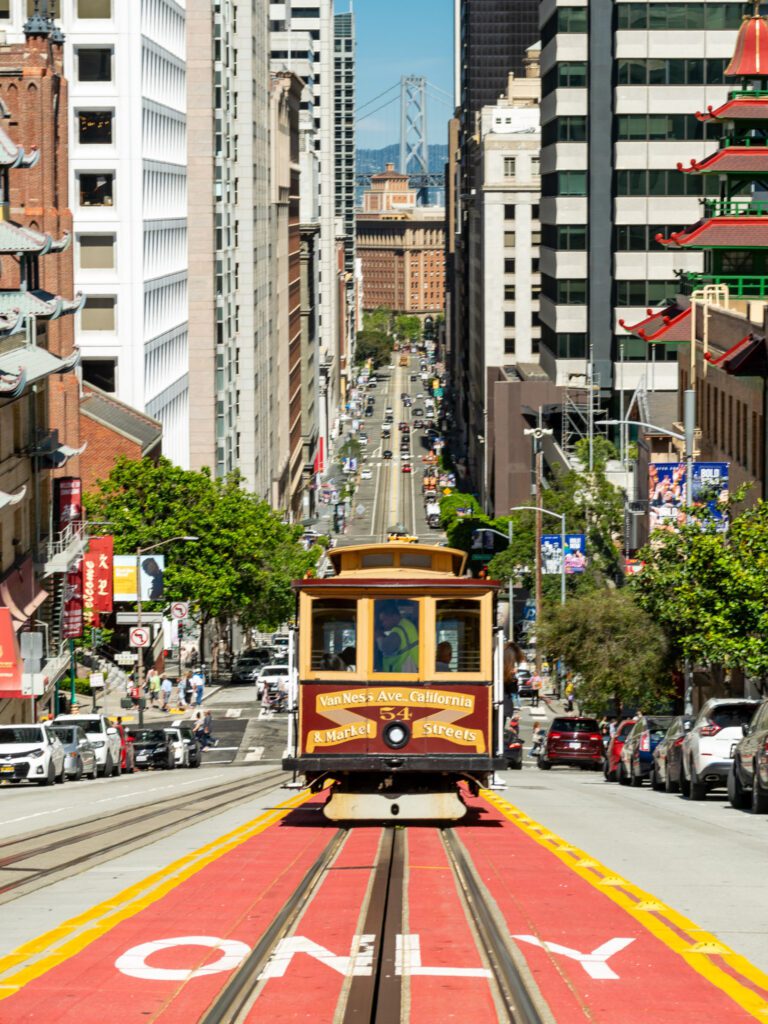
You have the (extremely photogenic) cable cars running up and down the street, with the Bay Bridge and the towering skyscrapers of the Financial District in the background.
At the top of the hill right on California Street you have the towering stone facade of Grace Cathedral.
It’s a gigantic church on the hill, and the stained glass windows are amazing. They host yoga sessions every Tuesday, which is super fun.
There are a couple of notable drink options in this little section at the top of the hill, though they’re more upscale and fancy than most in the city.
You’ve got the Top of the Mark, a rooftop bar in the Intercontinental Mark Hopkins with fantastic views of the city (and very expensive drinks) and the Tonga Room, a tiki bar in the basement of the Fairmont.
Between the two, we’d personally opt for the Tonga Room (we’ve been to both), but that’s because we’re not really fancy rooftop bar kind of people.
From there, make your way over to Polk Street and head south, which takes you right through the heart of our old stomping grounds in San Francisco.
Polk is the strip of bars, shops, and restaurants that runs through the middle of Nob Hill, and there are some GEMS along the way.
For Food: Hot Sauce and Panko is a somewhat hidden gem on Hyde Street with excellent hot wings. Bob’s Donuts for old-school donuts, including GIANT apple fritters (I used to go here for donuts to bring to work whenever I felt like the team needed a boost).
For Drinks: Head to Hi-Lo Club for cocktails (the bartenders here are super friendly, and helped us discover the lovely world of Oaxacan Rum!) or Robberbaron, a cozy little neighborhood wine bar.
For Shopping: Check out Cheese Plus for cheese, wine, cider, and more. Picnic for all sorts of stylish gifts and trinkets. Biondivino for an excellent selection of Italian wines. Russian Hill Bookstore for the best bookstore in the area with great greeting cards. ReLove for vintage clothing.
It’s worth taking a slight detour up to the Alice Marble Tennis Courts (here on Google Maps), which have a fantastic view of the Golden Gate Bridge from the top.

I used to play basketball here on weekend mornings, and it doesn’t get much better in terms of views from a pickup basketball game.
Explore San Francisco’s Chinatown
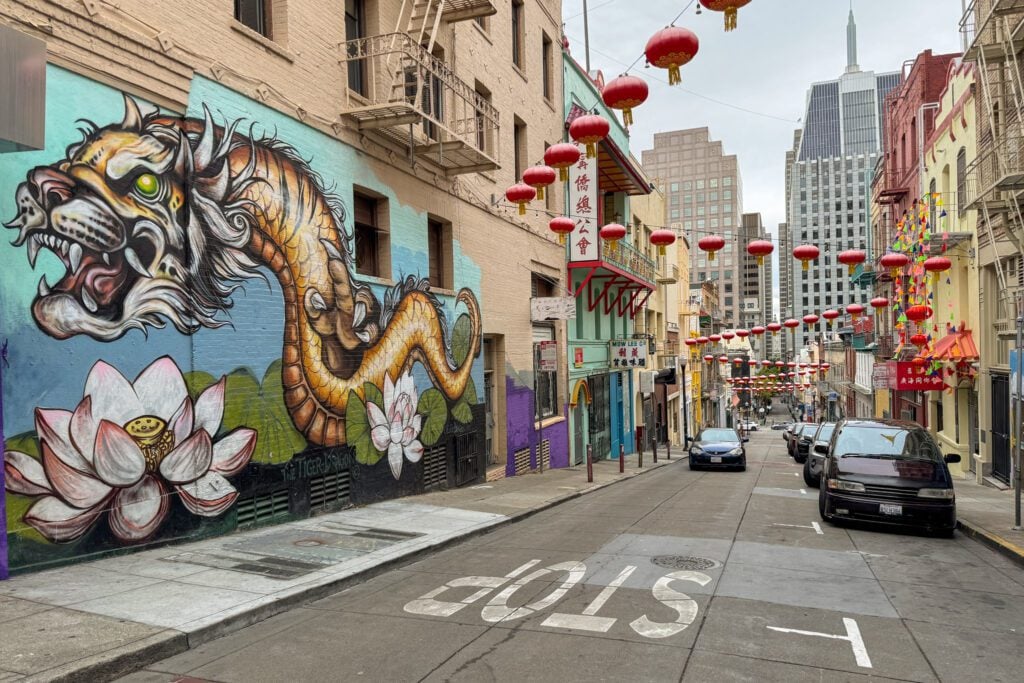
From the top of the hill, head downhill and you’ll end up in the heart of a few of San Francisco’s iconic neighborhoods – North Beach and Chinatown. We’d recommend doing a little afternoon stroll that incorporates the highlights of both of them.
If you’re up for some walking, this walk is about as beautiful as it gets. However, it does have some hills – you’re in San Francisco, after all!
Before you go, make sure to read about what Chinatown is and what it represents, which isn’t exactly a light read.
Widespread racism against Chinese immigrants in the 1800’s and laws that excluded them from other neighborhoods (sound familiar? It’s a common playbook) led to the creation of these communities that still exist today. It’s more than just a place to go to check out the Fortune Cookie Factory.
With that context in mind, it’s a fun neighborhood to explore.
We’d head to the Dragon’s Gate and the area around Grant Avenue, where you’ll find all sorts of shops and restaurants.

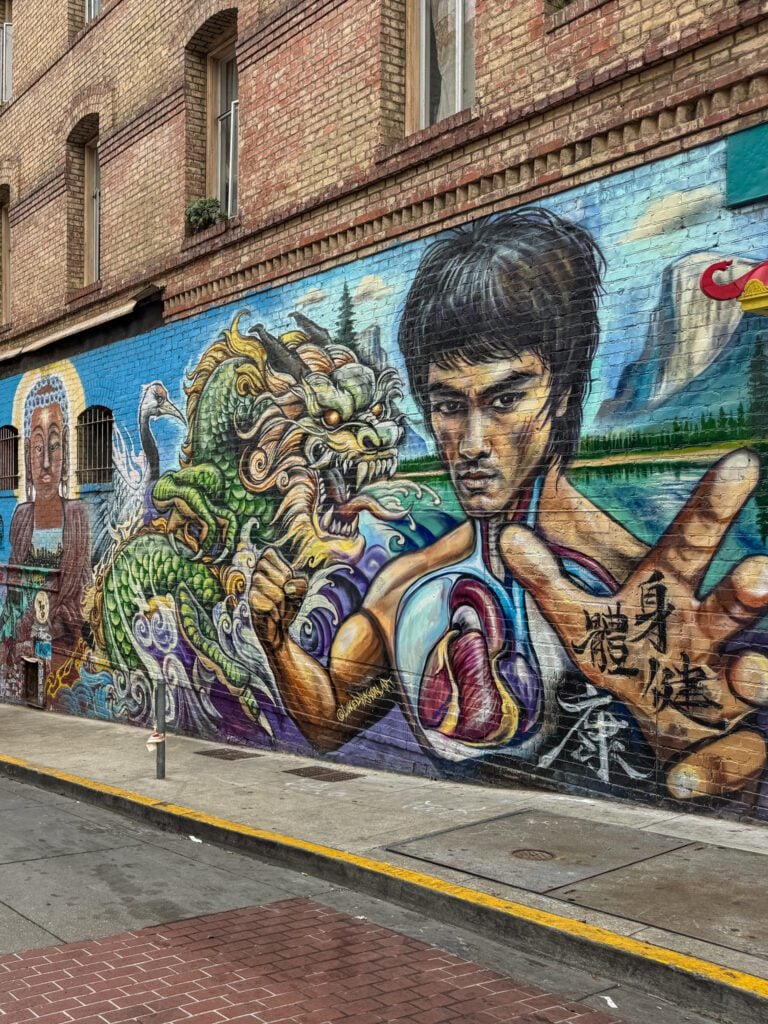
Unfortunately, I’m not the right person to help you explore the food, since I have Celiac Disease and can’t eat gluten (which is omnipresent in most Chinese dishes I’ve come across). Here’s a good guide to eating in Chinatown.
China Live, a big light-filled food hall (it’s kind of similar to Eataly for Italian food) that is part restaurant, part home goods store, all with a laser focus on Chinese food and culture. If you’re short on time and not really hungry, that’s a good stop to make.
If you really want to dive into the culture, history, and food in this slice of the city, we’d recommend this guided tour, which takes you around to multiple spots, including dim sum, Peking duck, and tea (among other things).
Whether or not you do that tour, we’d start at the Dragon Gate (here on Google Maps), which marks the boundary of Chinatown, walk north on Grant (there are some cool murals on the cross streets here), and finish on Columbus Ave, which puts you in the heart of North Beach.
North Beach & Coit Tower
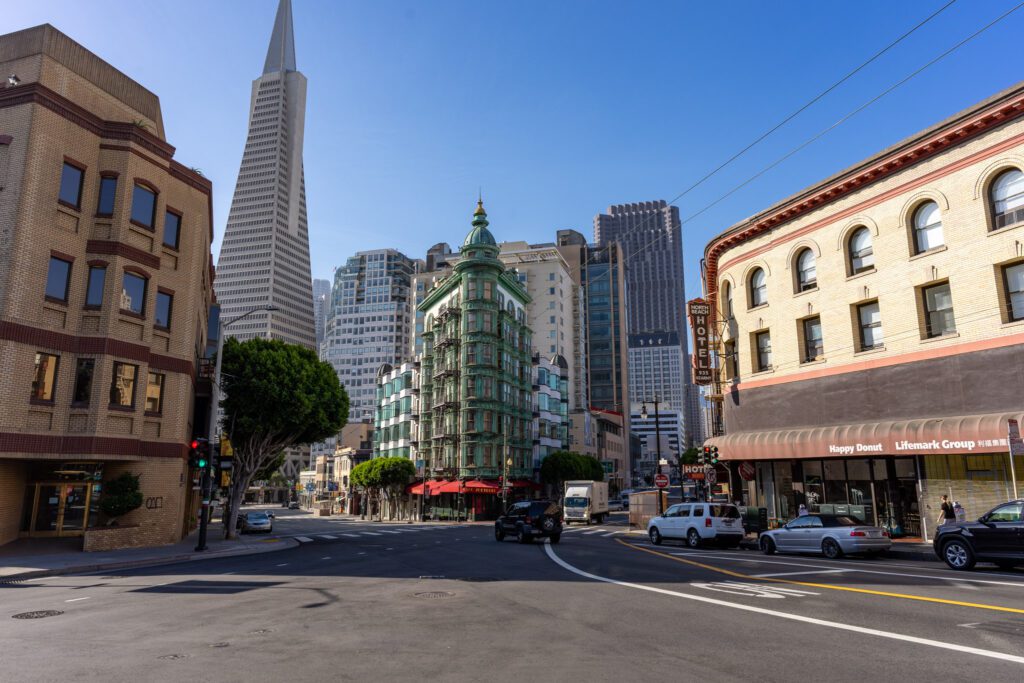
North Beach is at San Francisco’s northeast corner, and is a historically Italian neighborhood.
The Italian community in San Francisco settled here, and you’ll notice their impact on the area as you walk by one Italian trattoria after another.
North Beach today is also a nightlife hub, and the area along Broadway is full of light-up signs that come on after dark, advertising everything from theaters to gentlemen’s clubs.
The area we’d focus your time on is the stretch along Columbus Avenue, which runs diagonally through the center of the neighborhood.
On the south end of Columbus Avenue in North Beach is City Lights Bookstore, one of the best independent bookstores in California. SUPPORT INDEPENDENT BOOKSTORES. They’re particularly famous for their role in activism in San Francisco.
Tony’s Pizza Napoletana is one of our favorite pizza spots in the entire world. They’ve won awards in Italy for their pizza, which tells you everything you need to know, really.
They don’t take reservations, and there’s a line out the door from open to close. Don’t be surprised to find yourself waiting for two hours on a weekend afternoon or evening.
Obviously, you might not be hungry just yet, and we’ve got plenty of food lined up for you later in the afternoon. But if you’re wanting to sample the pizza, they have a pizza-by-the-slice spot next door.
We’d walk from City Lights up to Washington Square, which is a nice park where you’ll find all sorts of characters hanging out in the San Francisco sun.
Once you’ve taken in the sights and sounds of the park, head up the hill to Coit Tower, which involves some climbing no matter which way you slice it.
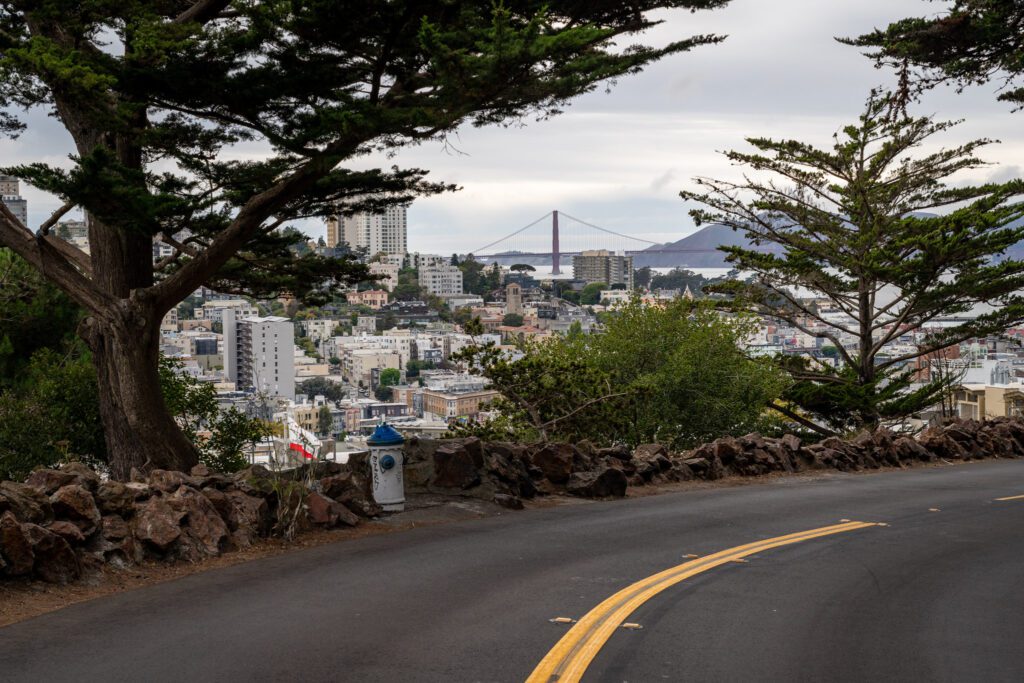


Coit Tower was built in the 1930’s at the top of Telegraph Hill as a monument to a San Francisco firefighter who died in 1929 and left a nice chunk of money to the city.
There are some really cool murals inside the tower that focus on the city during the Great Depression, and the view over the San Francisco Bay from the base is nice, and includes the Golden Gate Bridge.
It’s free to visit the ground floor murals, which is where most of them are found, but you’ll have to take one of their guided tours to see the murals on the second floor.
You can also go all the way to the top of the tower by taking the elevator, where you’ll have even better views of the city.
It is fairly expensive at $11 per adult, and we’d probably skip it if we were you, given that the views from the base of the tower are nice.
Both guided tours and elevator tickets can be booked here.
One of my favorite views of Coit Tower is from the top of Lombard Street.
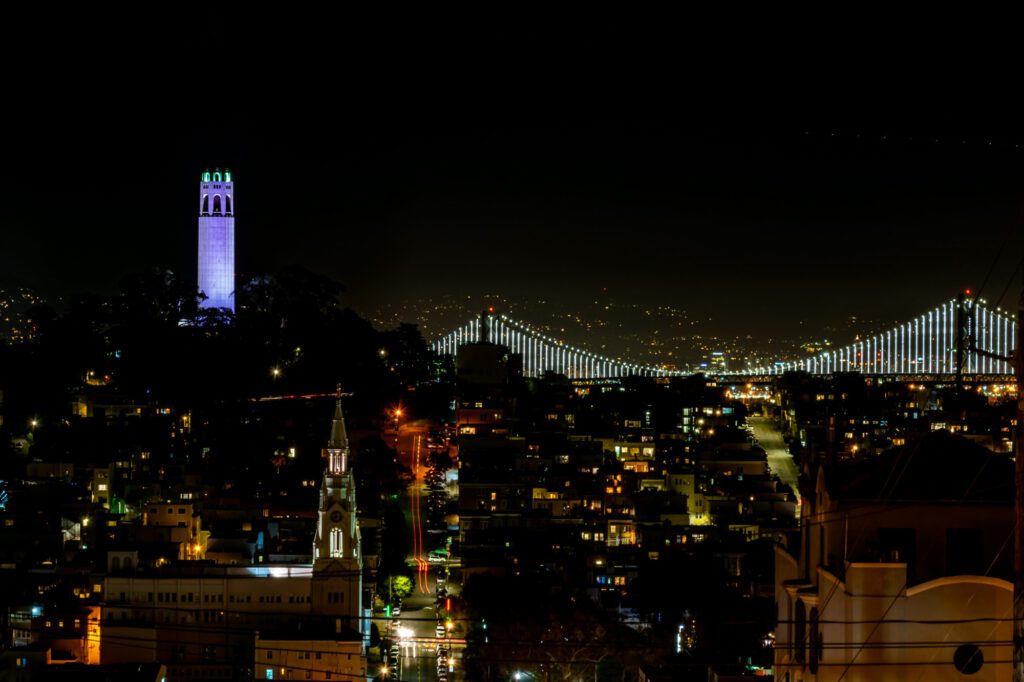
Well, really, it’s from the top of one of the streets in Russian Hill adjacent to Lombard – Filbert Street (here on Google Maps).
The Alcatraz (Night) Tour
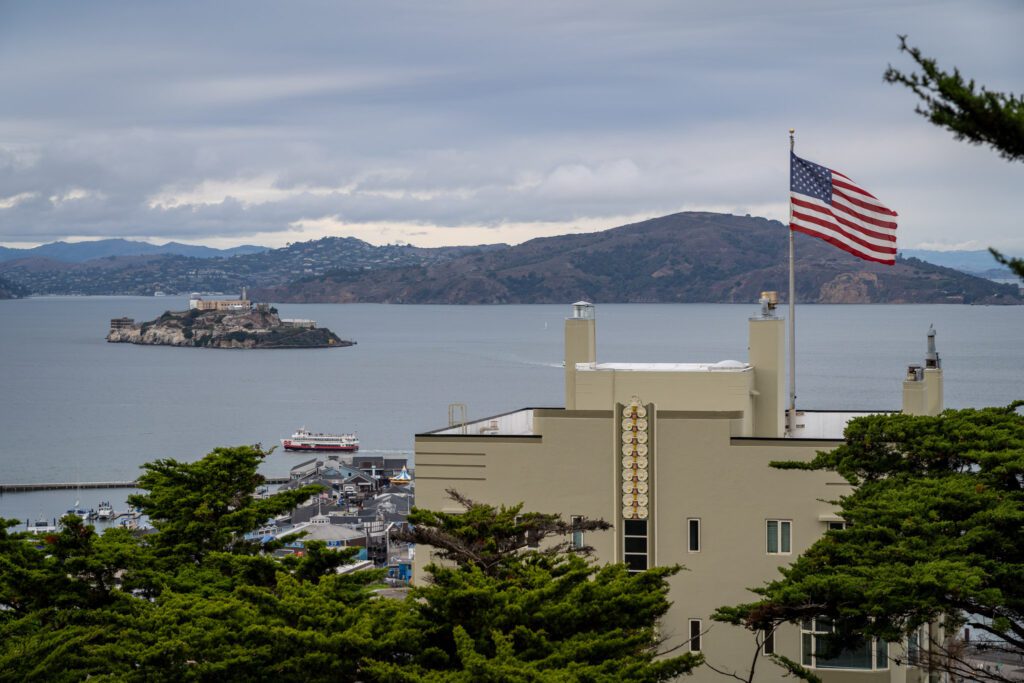
Visiting Alcatraz is one of those things that every tourist visiting San Francisco wants to do, but most locals haven’t thought about all that much.
That’s certainly true for Alysha, who spent her whole life in the Bay Area and only made it to Alcatraz for the first time a few years ago.
Alcatraz is a former federal prison that sits on an island in the middle of the San Francisco Bay. My earliest memory of Alcatraz is seeing it in The Rock, a fantastic “escape from Alcatraz” movie featuring Sean Connery and the legend, Nicholas Cage.
It might not look like it when you watch the likes of Cage and Connery do it, but the currents and freezing water make it nearly impossible to escape from Alcatraz.
It was a fully operational federal prison until the 1960’s, and has since become one of the most popular tourist attractions in the city.
If you were smart, you booked your Alcatraz Tour WELL in advance. They sell out months in advance. We’d highly recommend doing the night tour if you can – it’s spooky, and you get views of the city lit up at night, which is breathtaking.
We have only been to Alcatraz once, and it was for the night tour. It’s a super cool experience because you get UNBELIEVABLE views of the city from the island.
Day 2: Golden Gate Park & the Golden Gate Bridge
On your second day, move your focus to the western end of the city, with a morning brunch and a stroll through Golden Gate Park before ending with the best hike in San Francisco that ends at the Golden Gate Bridge.
Brunch at Zazie
Start your day with brunch. For whatever reason, people in San Francisco absolutely adore standing in line for brunch (it’s one of Matt’s least favorite past times).
Pick any Saturday or Sunday, drive around the city, and you’re sure to see people milling around outside the trendiest restaurants in the city waiting for their turn to sit down and enjoy a leisurely breakfast / lunch.
Since you’ll be exploring around Golden Gate Park today, it makes sense to head straight to one of our favorite brunch spots – Zazie.
We’ve legit waited for two hours for brunch here, and we’d do it again in a heartbeat. It’s also a good spot for dinner, for what it’s worth.
There are no reservations, and you put your name on the list and they’ll text you when the table is ready for you. It’s worth it for the benedicts.
Make sure to see if you can sit in their lovely backyard patio.
One other note – no tips here, they pay their employees a fair wage and it’s priced into the cost of your meal.
Stroll through Golden Gate Park
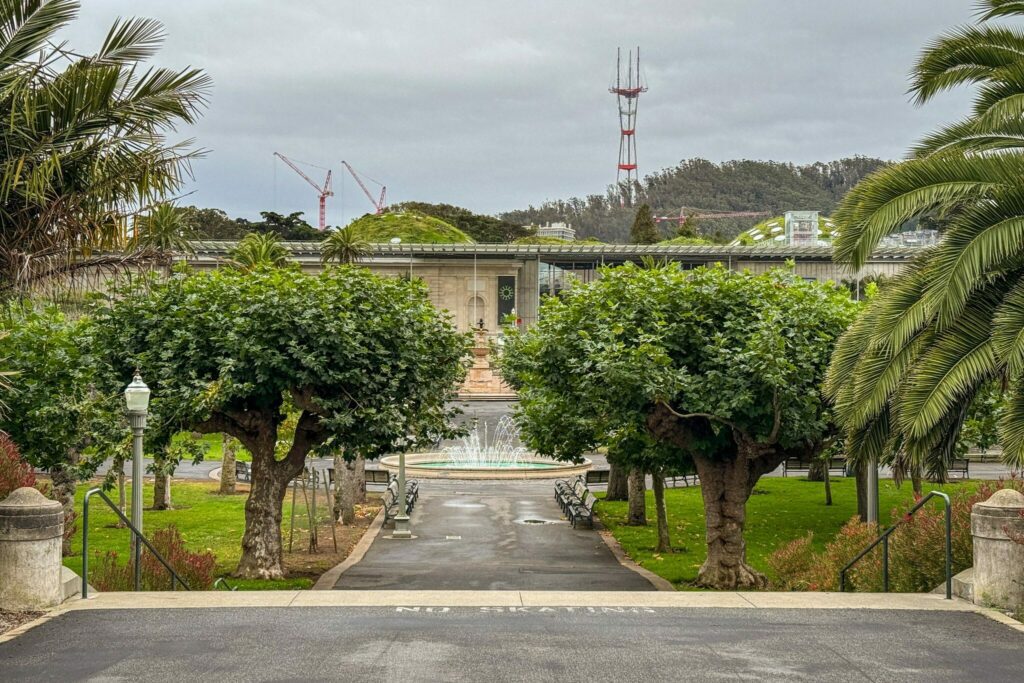
Golden Gate Park is a huge stretch of land on the western side of the city that stretches all the way to the ocean. On Sundays, they close the park to car traffic, making it a walker’s paradise.
My first apartment in San Francisco was on the northern edge of the park, and early in our relationship, long walks through Golden Gate Park were a weekend morning staple for Alysha and I.
At different points in our San Francisco journeys, both of us lived within a block or two of Golden Gate Park, a sprawling urban green space on the western half of the city that spans all the way out to the Pacific Ocean (really, a couple of blocks short, but close enough?).
Many of our early dates involved some sort of walk in the park, and that was the beginning of Alysha’s transformation of Matt from suburban kid who hates walking to someone that walks 12,000 steps a day and reads about urban planning in his free time (SF is great from that perspective compared to most American cities!).
The best part about Golden Gate Park is that it’s not just a green space. Similar to Central Park in New York City, it’s also a cultural center with several museums, a botanical garden, and a Japanese Garden to explore.
If you’re into Fine Art, the De Young is probably the premier museum in SF, and they have some really cool temporary exhibits that come through (on my last trip, I caught the Manga exhibit and, despite not knowing anything about Manga, I loved it!).
There’s also a free viewing platform at the De Young with nice views out over the city, including the tip of the Golden Gate Bridge. You take the elevator from the lobby, and again, no ticket required!
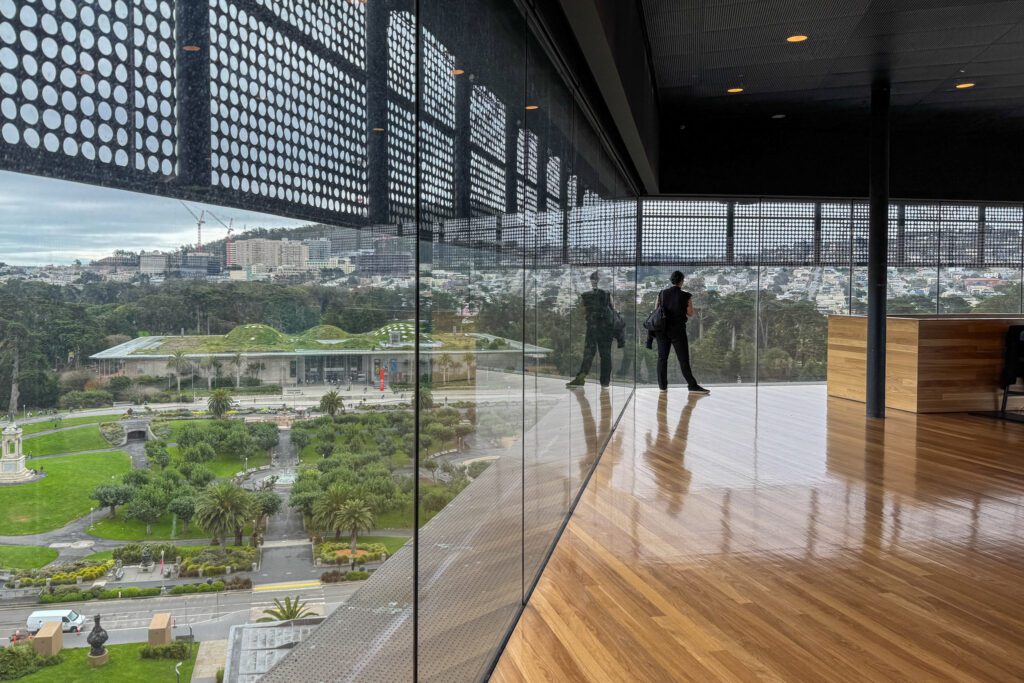
If you’re traveling with kids, there’s the Academy of Sciences (we used to go to their adults-only Nightlife when Matt lived nearby).
We also really like the Botanical Garden, and it’s free for SF residents.
The Japanese Tea Garden is a place that I have memories of visiting as a kid on school field trips. It’s a beautiful little oasis in the middle of Golden Gate Park, and they even have a tea house where you can enjoy a nice cup of tea in a beautiful, serene setting.
Two other nice spots in the park that fewer people visit are Stow Lake, where you can rent pedal boats and troll around the small lake, and the bison paddock. Yes, they have bison! Yes. Real bison. Find them here.
Here’s a walking route we’d recommend if you want to go from one end of the park to the other.
Ocean Beach & Sutro Baths

Your next stop is Ocean Beach, also known as the Pacific Ocean.
You can either take the scenic route through the park and make some stops, or grab a Lyft from the last destination in the park and head straight out to the beach.
The beach itself isn’t particularly special. And, to be frank, it’s usually foggy and/or windy and cold.
So don’t go into it expecting your picturesque southern California beach where it’s warm, sunny, and full of people in swimsuits. Instead, it will likely be cold, windy, foggy, and full of people in puffers and hoodies.
We do really like the view from Sutro Heights Park (roughly here on Google Maps) where, on a rare clear day, the beach stretches out for miles to the south.
The other place we really love in this neck of the woods is Andytown Coffee.
Whenever we’re nearby, we make sure to stop in, and think you probably should too if you want a quick caffeine hit before starting your hike.
Their signature drink – the snowy plover – is a delightful combination of espresso, sparkling water, and homemade whipped cream. YUM.
Trouble Coffee is another good spot nearby, more for their thick toasts topped with all sorts of delicious… uh, toppings?
Once you arrive at Ocean Beach, you’re going to start what might be the best urban hike in the nation, Lands End.
The Lands End Trail
Is this the best urban hike in the entire country? I think you’d be hard-pressed to find a better one.
This hike starts from the Pacific Ocean and follows the bluffs east towards the Golden Gate Bridge, which is where you’ll end your coastal California stroll.
Start at Sutro Baths, the ruins of a former bathhouse on the coast that was destroyed to build high end apartments (that were never started – read about the history here) and start on the Lands End Trail.
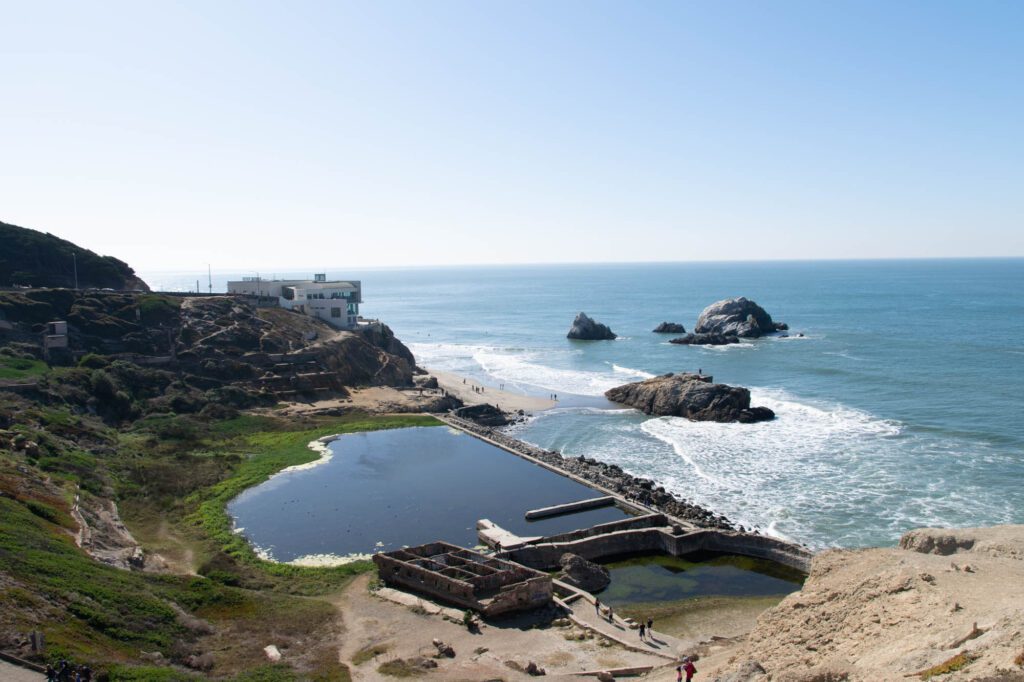
Take a second to walk down to the baths and admire the view. Then head up the hill on the north side and start on your hike.
You’ll wind around the coast and be rewarded with stunning views of the Golden Gate Bridge from all different angles.
We’d definitely do it from west to east, starting at Ocean Beach and ending at the Golden Gate Bridge, which will mean the bridge is in front of you the entire way.
Follow the trail to Baker Beach (here on Google Maps), where you can pause to enjoy the views of the Golden Gate (and watch out for the naked people at the north east end!).
Then make your way to Marshall’s Beach (here on Google Maps) for an up close and personal encounter with the Golden Gate Bridge (seriously, watch out for the naked people).
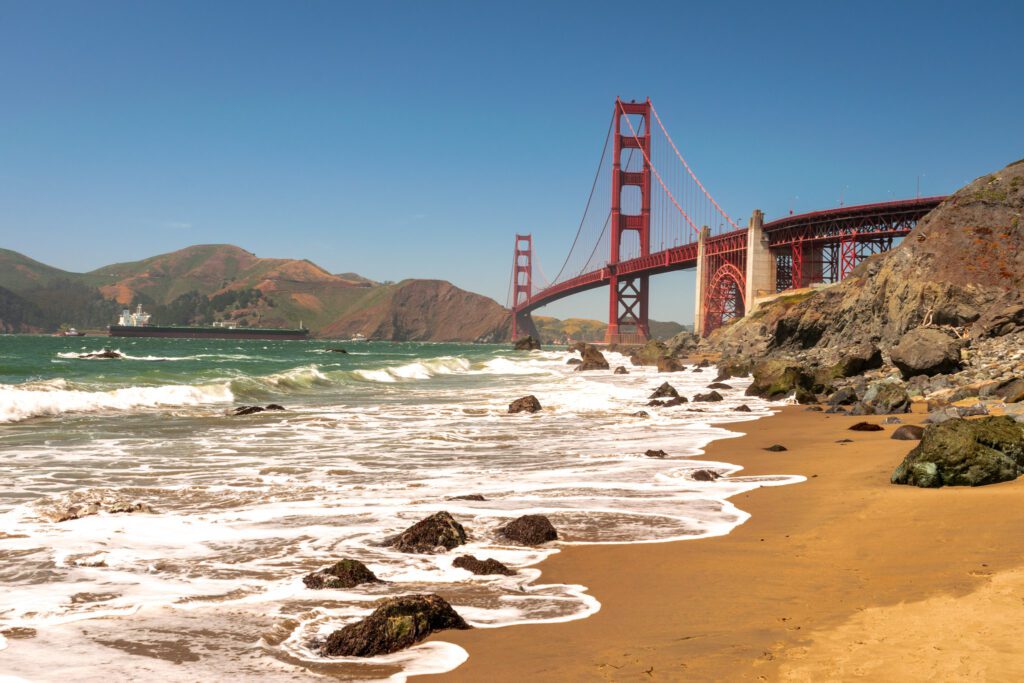
Finally, continue to the Golden Gate Bridge Welcome Center, where you can choose to walk across the bridge and back if you please.
Here’s a map of the route. It’s going to take you several hours. Take your time and enjoy the endless coastal beauty that the walk has to offer.
Sunset at the Golden Gate Bridge
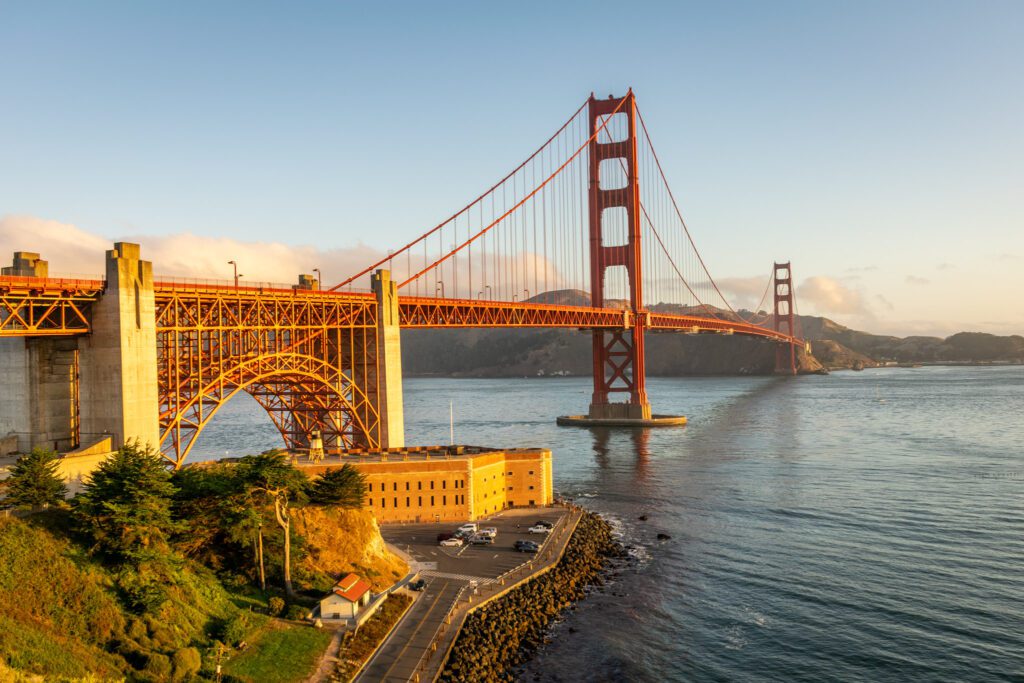
Finally, after a couple of miles of seeing the bridge get closer and closer, you’ll have finally made it to the Golden Gate Bridge Toll Plaza.
What’s the first thing you imagine when you think about visiting San Francisco? Most people would immediately say the Golden Gate Bridge.
What they don’t tell you in all the travel guides is that the weather at the Golden Gate Bridge is actually a little bit miserable on most days.
The location of the bridge means that it’s often foggy, windy, and cold. There’s a good chance that it’s one (or all) of those things when you visit, so make sure to bring plenty of layers!
A note: At least half of the time, the Golden Gate Bridge is covered by fog. Did you know that the fog in SF has a name? It’s Karl. Karl the Fog.
If you have a clear day during your time in San Francisco, take advantage and head to the bridge. Fair warning – even though it’s sunny downtown, it might be foggy at the Bridge.
We actually don’t think it’s really worth walking fully across the bridge just to do it (though we do like walking across the bridge and to Sausalito on the other side).
When you’re at the bridge, there are a few places we’d make sure to hit for great photos.
- The Main Viewpoint: Go here for the classic view of the bridge.
- The Cypress Trees View: Go here for the bridge framed by a couple of photogenic trees.
- Marshall’s Beach: A little further – about two miles round trip from the parking lot – this is the best view of the bridge in the city, hands down. It’s better at sunset, when the golden light of the setting sun lights up the bridge in a brilliant red color, but the morning light will do just fine.


Definitely do some exploring of the batteries (that’s the old bunker-ish things) too, which are a unique aspect of this part of California.
Another cool spot to see the bridge is from below, which you can do at Fort Point. It’s a 0.7 mile downhill walk from the toll plaza, and if you don’t have a car, you can plan on catching a rideshare to your next stop from here to avoid having to walk back up the hill.
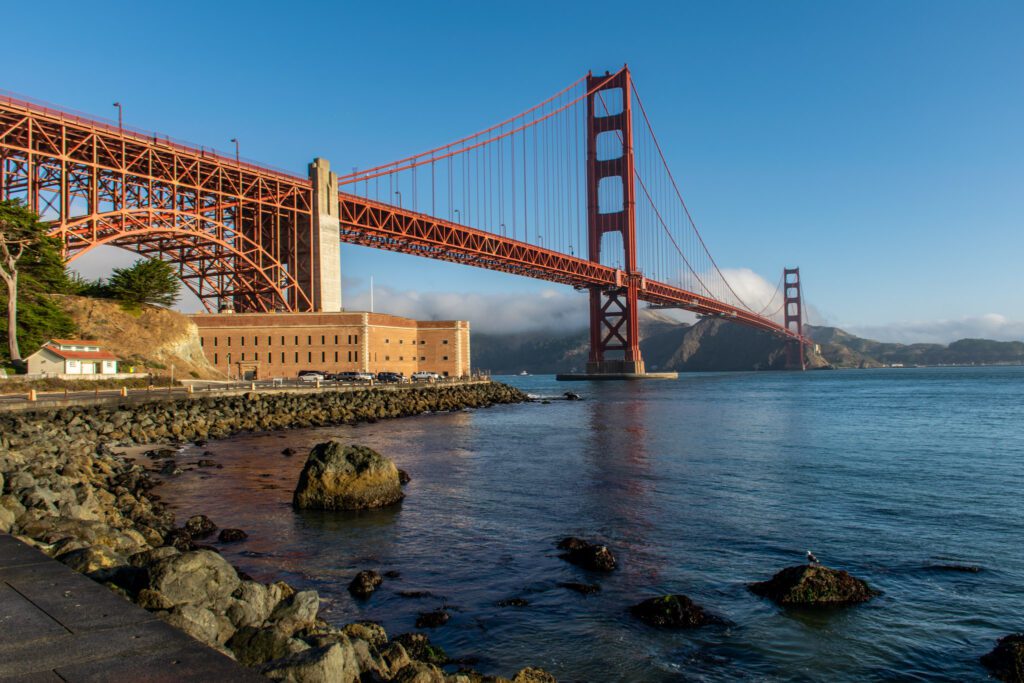
Day 3: NoPa and the Mission District
On your third day in San Francisco, spend your day walking through some of our favorite neighborhoods in San Francisco – NOPA and the Mission – with plenty of time for food along the way.
Breakfast + Coffee in NoPa
NoPa means “north of the panhandle,” and is a charming residential neighborhood on the eastern edge of Golden Gate Park.
It’s the place to go to see old Victorians, and you’ll find them all over the streets (though the most famous are the Painted Ladies, which were featured in Full House).
This area is a great place to start your day, which, SPOILER, is going to be full of food.
The main thoroughfare in this part of the city is Divisadero Street, and there are a couple of places worth noting in terms of breakfast, brunch, and coffee.
First, coffee. Sightglass Coffee Roasters is probably my top coffee shop in the area, and they have a location right on Divisadero Street.
If you’re in the mood for a more hearty brunch, head to Brenda’s Meat & Three. The sister restaurant to Brenda’s Soul Food, which is a famous brunch spot in the Tenderloin, this place has essentially the same menu with a better location and much smaller lines.
They serve “French Soul Food” inspired by the owner’s experience growing up in Louisiana.
Get the beignets and the biscuits and gravy (definitely not gluten free, for my Celiac friends – this is not the place for us, sadly, but my family and friends all love it!).
If you’re more in the mood for pastries, there are two great options in this part of town, which is where Matt lived for four years before we moved in together.
Again, neither has gluten free options, which is why Matt makes other people do the hard work of eating delicious croissants and various other pastries to help him evaluate.
B Patisserie: A bakery that has been written up over and over again, this place is on the same street as Brenda’s, so if you’re really hungry, you can combine the two into one, super rich brunch extravaganza.
Their take on French pastries is a little more modern, combining classic French techniques with more innovative flavor combinations. They have a huge selection of pastries that changes constantly, but know that they do sell out of the most popular items so go early, if you can.
Arsicault Bakery: This place (technically in the Inner Richmond, a ways away) was right on the route to our local farmers market every weekend, and I never once saw a line here until one Sunday morning shortly after Bon Appétit wrote them up as one of the best new bakeries in the country in 2016, specifically calling out their croissants.
Now, there’s a line that wraps around the block every weekend morning, and they consistently sell out of their buttery croissants by noon (if not earlier).
There are plenty of other options too, like Pain au Chocolat and some savory options, but you should definitely try the croissant at least once.
Alamo Square and the Painted Ladies

After breakfast and getting your shopping fix, stroll up to Alamo Square and the Painted Ladies, made famous by the TV show “Full House.”
Once you get off Divisadero Street, you’ll start to realize that Victorians are actually a fairly common thing to see in this part of the city, and you’ll wonder how these happened to get famous.
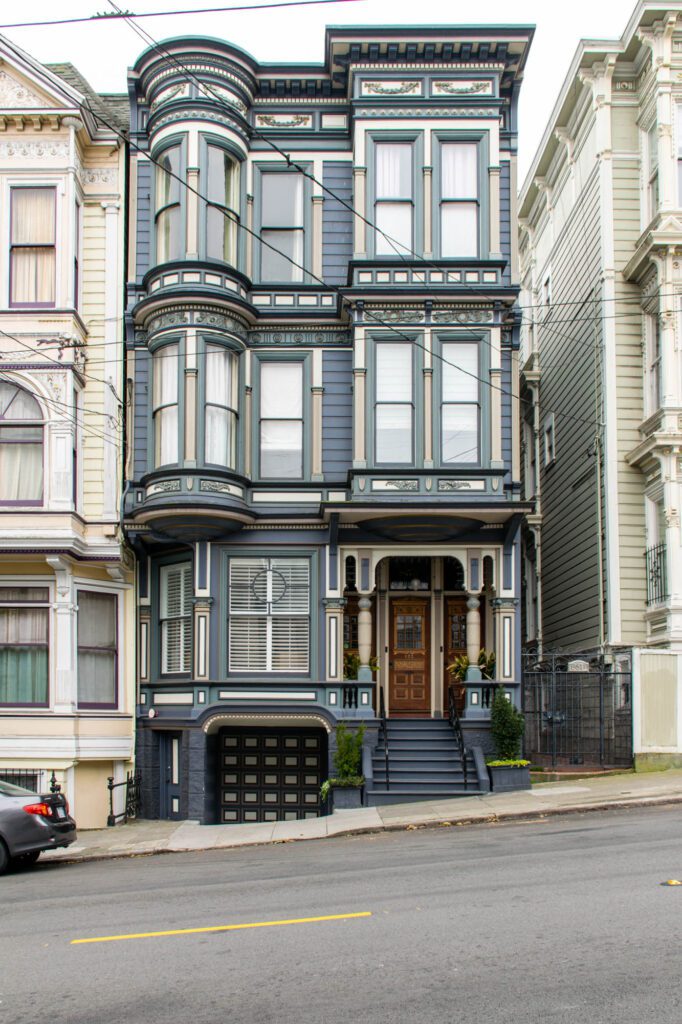

It’s mostly because of the view from Alamo Square, the park across the street, where you’ll have a nice view of the Ladies in the foreground, with the San Francisco skyline in the background.
Did you know this is the most photographed spot in all of San Francisco?
If you’re there on a weekend, hit up the Lady Falcon Coffee Club truck in the middle of the park for another cup of joe. This time, from a local female-owned and operated business.
Corona Heights Park
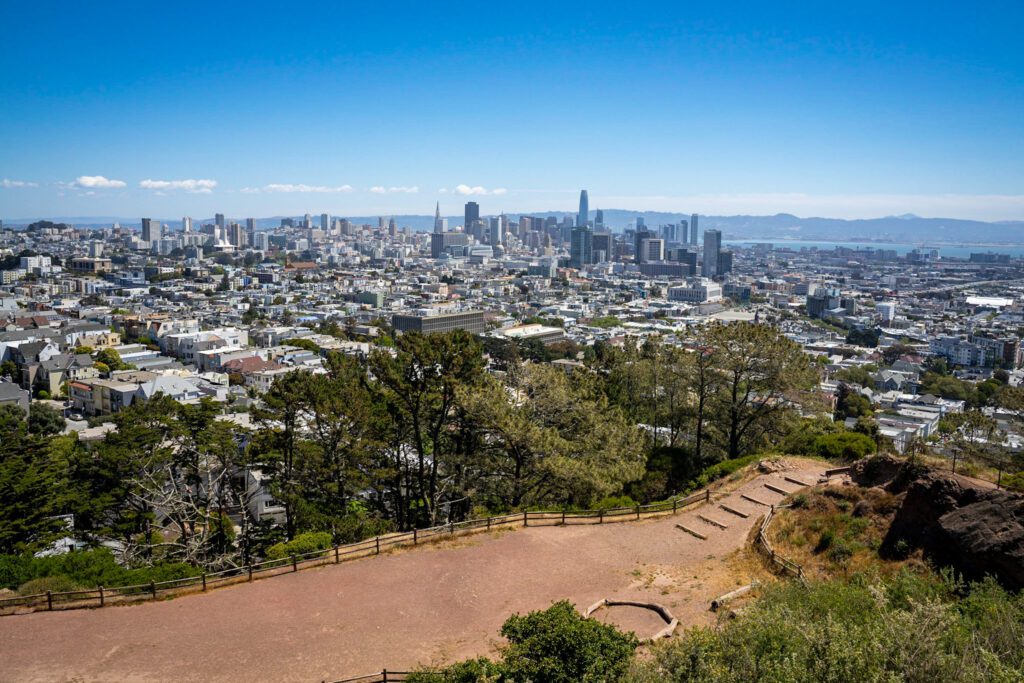
Most people will send you up to Twin Peaks, which is no doubt an excellent view of the city, but it’s constantly packed with tourists looking for that picture perfect view of the downtown San Francisco skyline with Market Street acting as a great leading line in the foreground.
However, we’d point you to a much less visited spot – Corona Heights Park – where you get a similar view without all the crowds.
You can find it here on Google Maps.
From there, walk down into the Mission District, where you’ll be spending the rest of your third day in the city.
An Afternoon + Evening in the Mission

The Mission District (just referred to as “The Mission” by most) is easily one of our favorite neighborhoods in San Francisco for a few different reasons.
First is the weather. San Francisco locals know that the city is full of different microclimates, and the Mission is consistently at least 5 degrees warmer and free from the fog that descends on the rest of the city.
We’ve been in situations where it’s 48 degrees, foggy, and windy at our house in Nob Hill, and a mile away in the Mission it’s 65 and clear blue skies.
Second is the food and drinks.
There is no better neighborhood to eat your way through than the Mission. From famous bakeries and ice cream spots (there are two!) to taquerias and Burmese food, the Mission basically has it all.
Last, but certainly not least, is Mission Dolores Park, which is probably the best park in San Francisco after Golden Gate Park.
For those reasons, we think that the Mission is a must-see on your trip to San Francisco.
However, you should know that it’s one of the fastest-gentrifying areas of the city, and it shows.
You’ll pass by people from all walks of life in the Mission, which is evident when you walk down Valencia Street and see brand new hipster coffee shops and home goods stores next to Mexican grocery stores and taco shops that have been there for decades.
It’s worth remembering that the Mission – which is San Francisco’s oldest neighborhood and where you’ll find the oldest remaining building in the city – has traditionally been home to the Latino community in San Francisco.
Until recently, that is, when rapidly rising rents have pushed out residents who have lived there for decades in exchange for tech workers and hip brunch spots and fancy cocktail bars.
We’re not going to solve gentrification here, and completely recognize that part of the reason we love spending time in the Mission is the bars, restaurants, and shops that are a direct result of that gentrification.
Instead of trying to solve it, we’d encourage you to read this piece in the SF Chronicle about the Mission’s history and how it is changing to understand the issues facing the neighborhood.
It’s also well worth stopping at Clarion Alley (here on Google Maps), a vibrant collection of murals that features bright colors and biting commentary on current social and political issues.
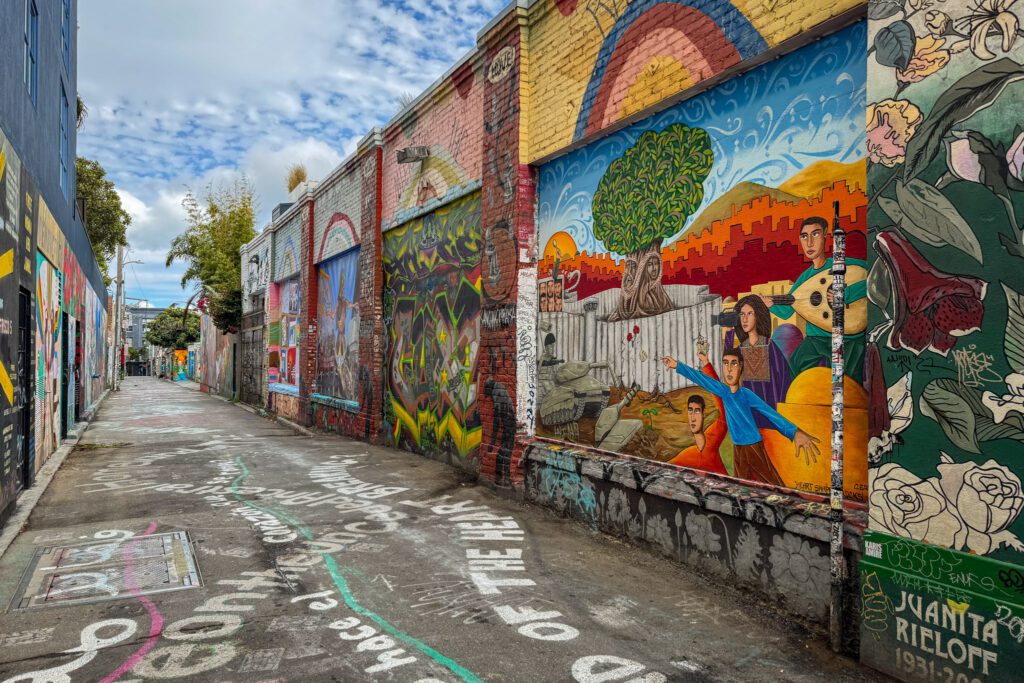
In particular, you’ll find a lot of commentary on the immigrant experience in San Francisco and the United States as a whole, and on rising inequality in a city where the gap between the richest and poorest residents continues to grow at an alarming rate. More information on the project here.
Here’s what we’d do with your time in the Mission.
Visit Mission Dolores Park: Mission Dolores (or the proper name, Mission San Francisco de Asís) which is a few blocks north of the park that is named after it, is the oldest intact building in the city.
It was built wayyyy back in 1776, when the Catholics showed up with a mandate to evangelize the indigenous people who had called California home for millennia. A tale as old as time.
You can see the original mission next to the newer, bigger, more opulent basilica at the corner of 16th and Dolores.
The park, on the other hand, is one of the most popular parks in the city, especially on warm, sunny days, when you’ll find hundreds (thousands?) of people flocking to the park with their picnic blankets and boozy beverages, clad in the smallest possible amount of clothing, to enjoy the sights and sounds of the Mission.
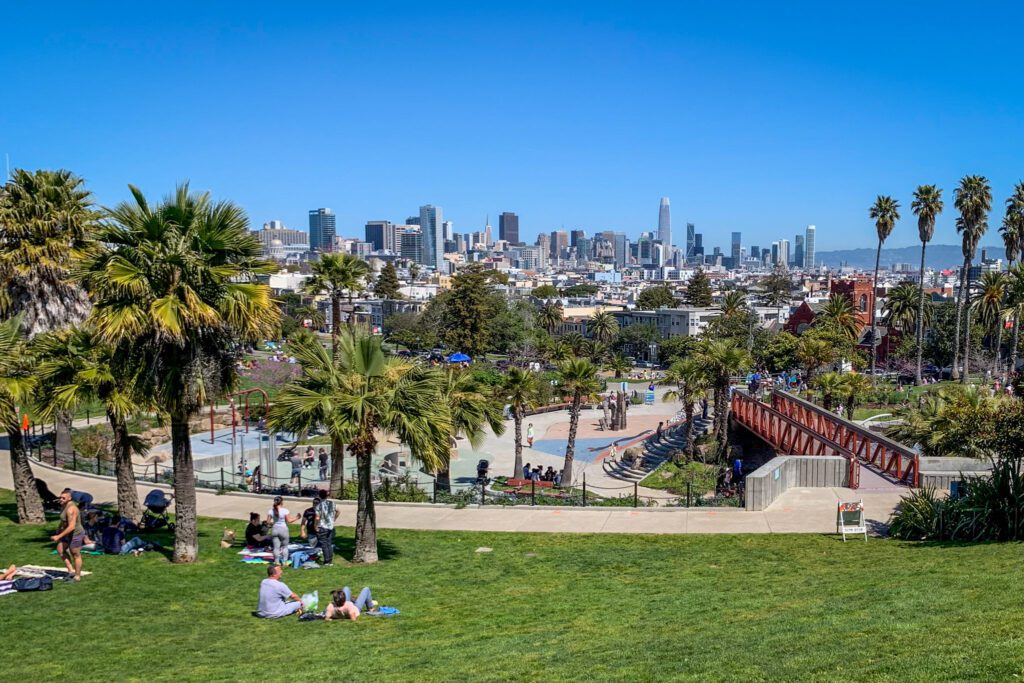
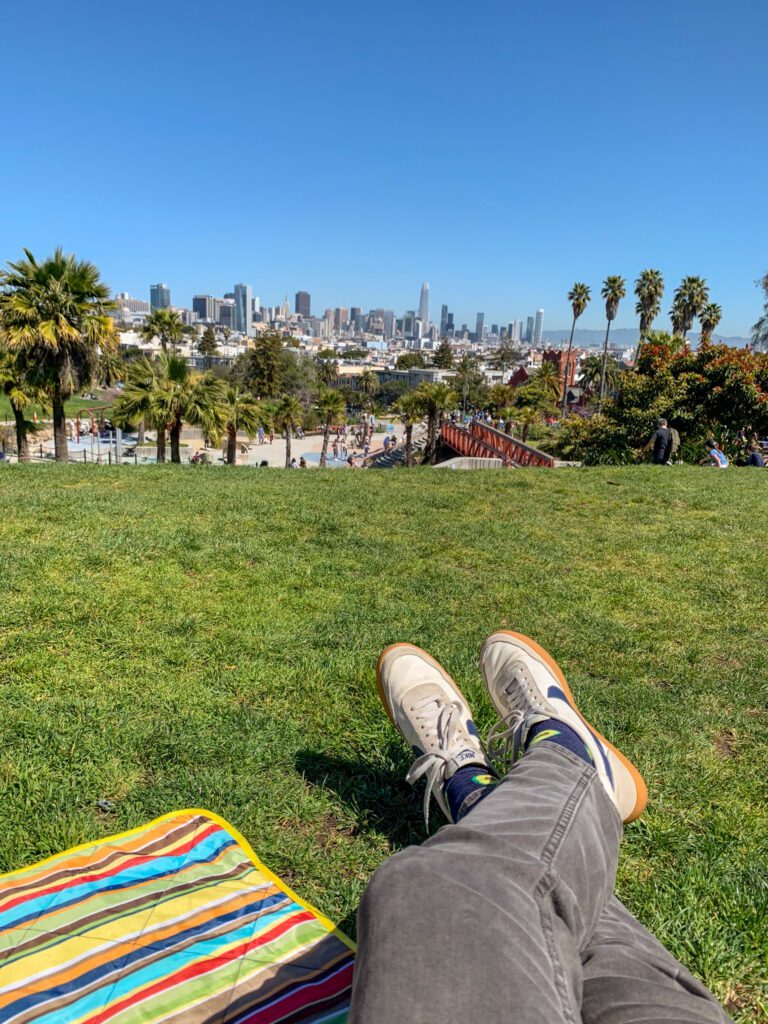
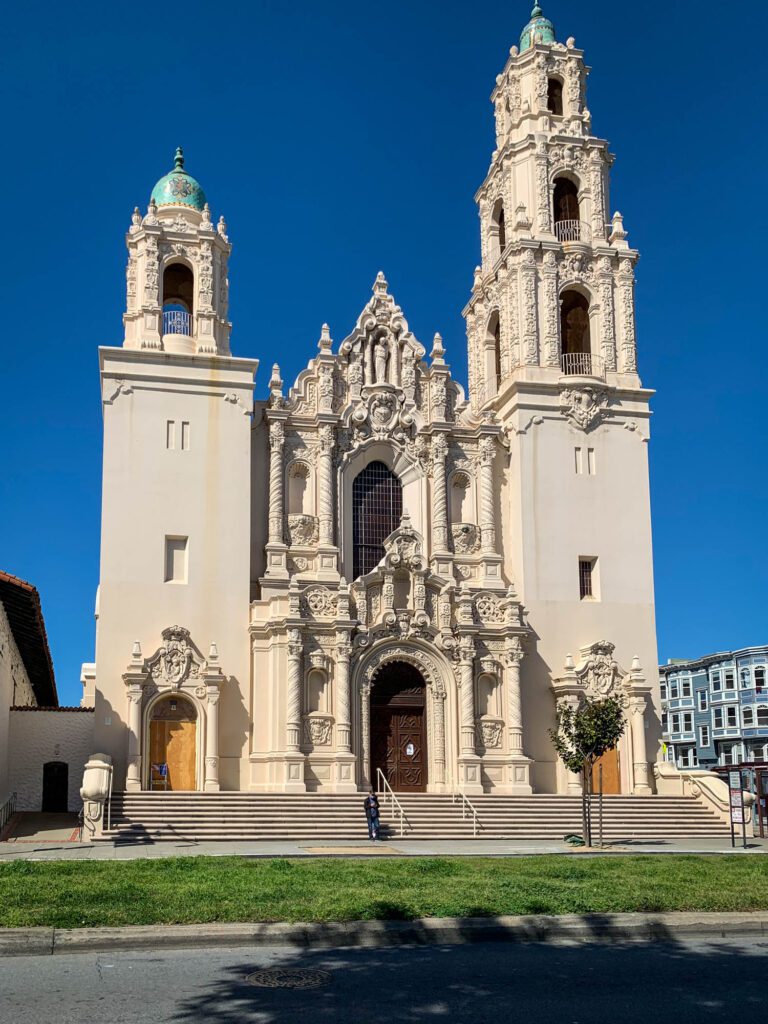
This is a fun place for a picnic lunch or picnic happy hour, and you can grab supplies at nearby Bi-Rite Market which has a good selection of wine, beer, cheese, crackers, and whatever else you’re craving.
Kitty corner from the park is one of Alysha’s favorite places in San Francisco – Bi-Rite Creamery, which is probably the best ice cream in the city.
Eat and Drink Your Way through the Mission: From affordable taquerias to more upscale restaurants, the Mission has a great range of food and drinks to enjoy. We’d recommend staying in the neighborhood for dinner and drinks, where you’ll have a smorgasbord of choices.
Here are some places we love.
Tartine: This bakery on the corner of 18th and Guerrero is Instagram and Netflix-famous (and just about every other form of media too).
This small, cozy bakery is the original location, where you’ll find all sorts of delectable, definitely NOT GLUTEN FREE treats like croissants and other kinds of pastries alongside life-changing breads.
Alysha has a list of places that she will eat gluten (most of the time she doesn’t because I have Celiac Disease, and it makes life easier for both of us) and this is on it. They have a bigger, more brunchy space a few blocks away called the Manufactory, too.
Taquerias: The Mission is probably most famous for its taquerias. Go to La Taqueria for Mission style burritos, and Taqueria El Farolito for tacos. Of course, there’s a nearly endless number of different options in the area – here’s a guide for you to find the perfect taqueria for yourself.
Burma Love: Sister restaurant of Burma Superstar, which is one of our favorite places to eat in San Francisco (and was right near my first apartment in the city). If you’ve never had Burmese food, this is the place to do it. Get the tea leaf salad (duh) and the chicken curry.
Pizza in the Mission: Alysha loves Little Star Pizza, a San Francisco institution, but when we asked our friends who lived in the Mission what their go-to pizza spot was, they responded with Cellarmaker Pizza, which is a bit further south and is a place to get both pizza and beer (Cellarmaker Brewing is the brewery that owns it). Other great options are Flour + Water Pizzeria and Pizzeria Delfina.
For drinks,we’d head straight to ABV, our absolute favorite cocktail bar in the city. Hands down.
Day 4: A Day Trip (Choose Your Own Adventure)
On your last day, we’d recommend getting out of the city on a day trip. Since we’ve already covered the fact that you definitely shouldn’t rent a car if you can avoid it, we’ll give you some options for a car-free day trip, which is going to involve booking a guided tour in some cases.
Unfortunately, we don’t really view Yosemite or Lake Tahoe – which are both 4-6 hours away, depending on traffic – as viable day trip destinations from SF (though that doesn’t stop people from doing it!).
The three day trips we’d focus on are heading north to Muir Woods, across the Golden Gate Bridge to Sausalito (which is also north, we realize), or heading to wine country for some wine tasting (which is…also north).
Option 1: Walking the Golden Gate + Sausalito (Our Top Pick)
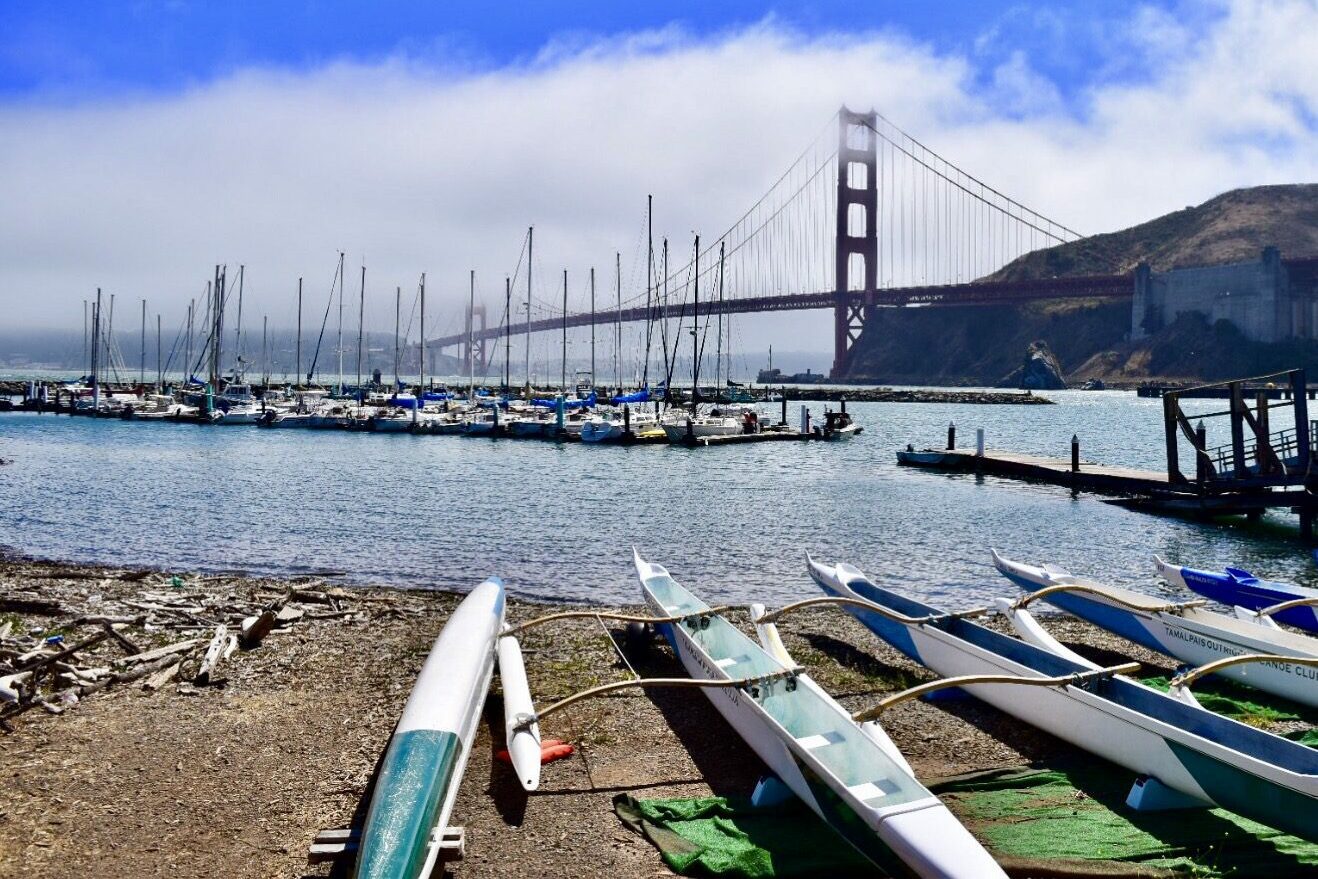
The ultimate day trip option, we think, involves walking across the Golden Gate Bridge (which can be blustery and pretty miserable) and down through Sausalito, a beautiful coastal enclave that sprawls down the hill into the Bay that reminds me of the towns of Cinque Terre.
Grab lunch and coffee (or a drink), and then take the ferry back across the Bay to the city.
We’ve personally done this option multiple times, and we enjoy it every time. Here’s the route we’d take, and the stops we’d make.
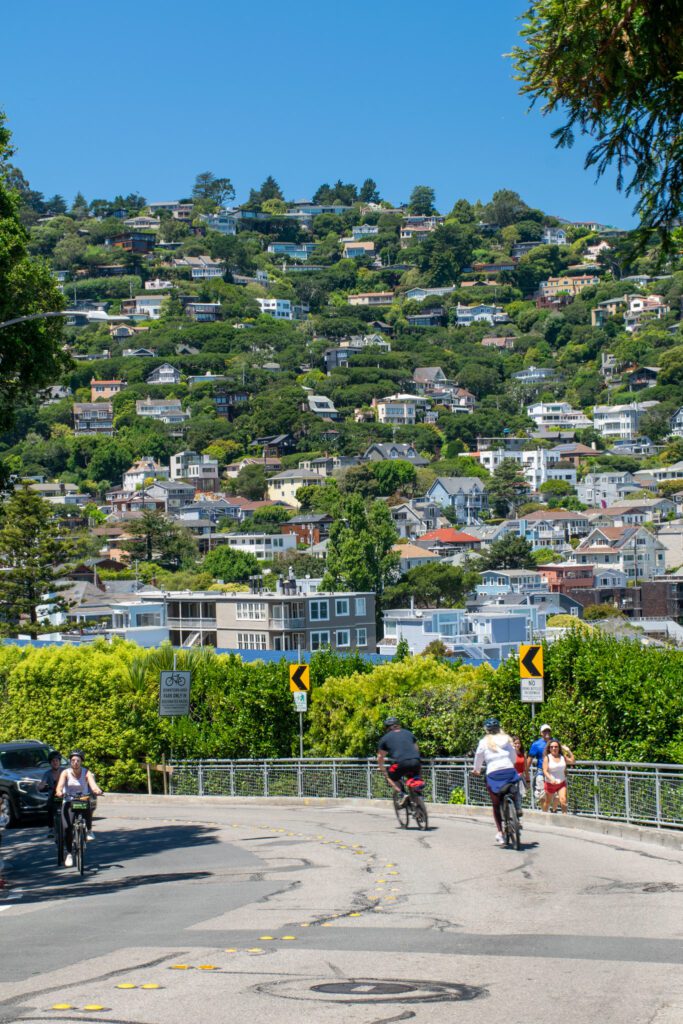
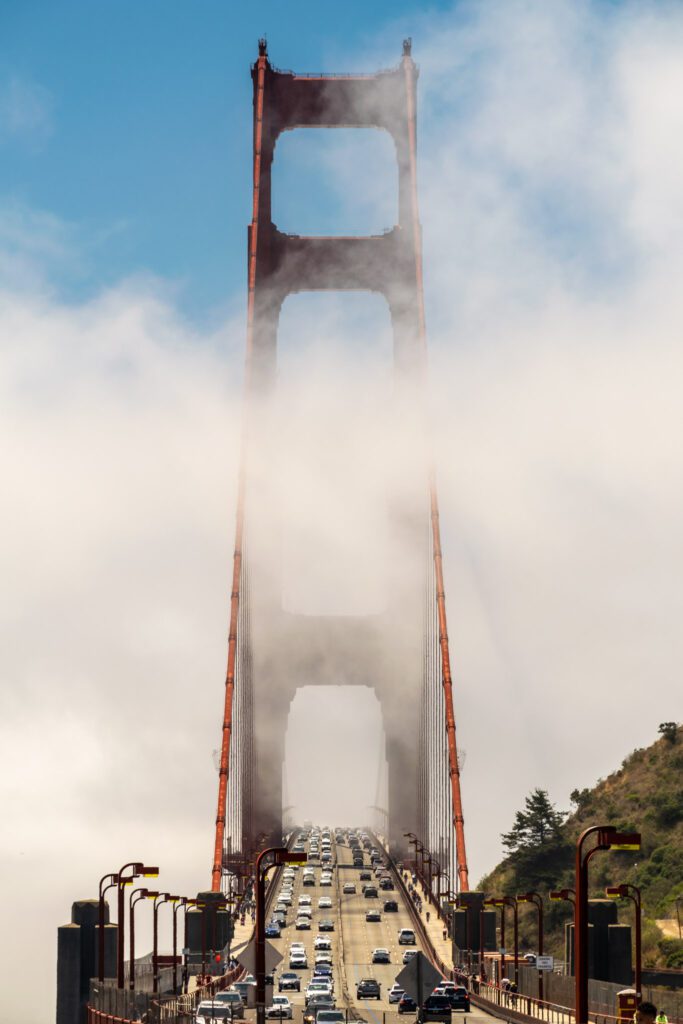
Start from the toll plaza on the southern end of the bridge, and make sure you’re on the eastern side of the bridge (which we think has better views because you’re looking towards the core of the city, along with Angel Island and the Bay).
Walk across the bridge, and try not to get run over by a cyclist on the way.
It’s about two miles across the bridge, and you’ll end up at a nice view of the bridge from the other side. From here, you’ll use the pedestrian underpass to cross to the other side of the bridge.
As an optional side trip, you can walk under the bridge and up the hill to Battery Spencer, which is arguably the best view of the bridge from this side (here on Google Maps).
Follow the path down the hill (and back under the bridge) to the Presidio Yacht Club, which has both an excellent view of the bridge with the boats in the foreground, and a cozy little bar to grab a quick refreshment before you continue on the journey.
From here, you’ll walk along East Road to meet up with Alexander Ave, which will take you down into the heart of Sausalito.
Here’s a map of that walk with all of the stops we talked about for planning purposes.
The main drag of Sausalito is full of places to eat, drink, and shop (along with a bunch of fine art galleries). Two spots that jump out to us are Copita, a 100% gluten free Mexican restaurant (they catered our wedding) and Lappert’s Ice Cream, but there are a nearly unlimited number of storefronts to explore.
There’s also an Equator Coffee on the far end of the main stretch if you need a caffeine boost.
From there, you can head to the ferry terminal (here on Google Maps) and catch the ferry back to San Francisco, which will land you at the Ferry Building after a 30 minute scenic ride. You can find the ferry schedule here.
The ride costs $14 for adults ($9.25 with a Clipper Card, which you can add to your Apple Wallet – more information here), $7 for kids over 4 (under 4 are free!).
Option 2: Muir Woods
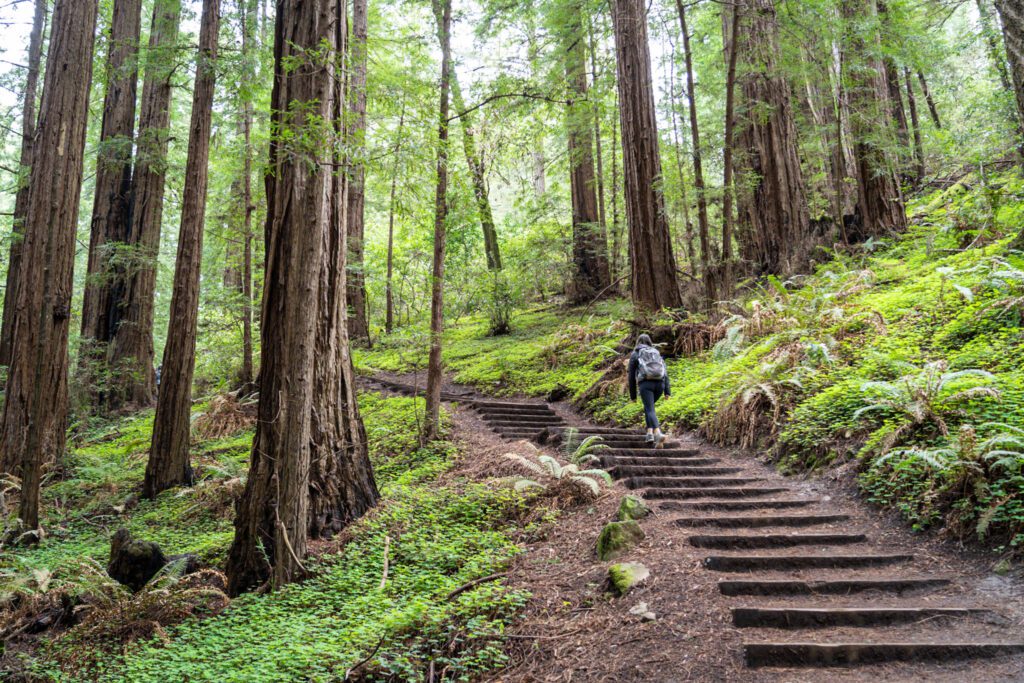
Truthfully, our top recommendation would be heading to the Marin Headlands for a scenic drive and some hiking, but that would involve renting a car (or getting a Zipcar) to explore north of the city, which we realize isn’t possible for everyone since we literally told you DO NOT RENT A CAR at the top of this guide.
Don’t worry – we have an alternative tour that you can join if you’re car free.
Marin County, which is where Alysha grew up, has some of the best hiking in the Bay Area (plus the redwoods). A perfect self-drive half day itinerary would look something like this:
Grab breakfast on your own and drive over the Golden Gate Bridge into Marin.
Stop at Equator Coffee on Highway 1 for some tasty coffee.
Stop at Muir Woods to see the towering redwoods of Northern California – note that you will need to make a reservation in advance for parking or the shuttle (runs weekends and holidays only).
Hike either Tennessee Valley Trail (SPECTACULAR coastal views) or to the peak of Mount Tamalpais (views across the Bay Area and to the city on a clear day).

Stop at Flour Craft Bakery (100% gluten free!) in Mill Valley on the way back for some lunch – get the blackberry earl grey scone and thank us later.
Drive over the Golden Gate Bridge back into the city. You pay on the way back into the city, and you don’t need to stop – they’ll mail you the bill.
If you don’t have a car, this is going to be a little bit harder to pull off. In that case, we’d recommend focusing on Muir Woods instead, which is basically the only place where you can find a guided tour.
Here’s a highly rated guided tour that would be at the top of our list (plus it includes a stop in Sausalito).
Option 3: Take a Trip to Wine Country (Napa or Sonoma)
Some of the most famous wine country in the entire world is just an hour or two north of San Francisco. Napa Valley is the most famous, and also the most expensive and crowded.
It’s where you head for the big cabernet sauvignons and overly oaky chardonnays, which is very much NOT our vibe.
Instead, we’d opt to head to Sonoma, which is a less famous but equally interesting wine region adjacent to Napa where you’ll find significantly cheaper tastings that don’t require advance reservations (in some cases), and feature more pinot noir and less robust whites.
We’re assuming you don’t have a car, which means you’re going to need to hop on a guided tour if you want to do some wine tasting.
Which, if we’re being honest, is probably the best approach to enjoy the wine without having to worry about drinking and driving.
As soon as we saw this wine tasting tour in a vintage VW Bus, we knew it had to go on the list. Note that this tour DOES NOT include tasting fees or lunch, just the transportation to and from San Francisco and between wineries.
An alternative would be this small group Sonoma wine tour, which DOES include wine tasting fees at three wineries (but not lunch) and also includes a stop on the way home at Sausalito and the Golden Gate Bridge.
What to Do with More Time in San Francisco
If you happen to have more time in SF, here are a few more ideas.
Add a Day Trip (+1 Day)
With a full extra day, the first thing we’d probably add is another day trip.
Three days is a good start to exploring SF itself, and one of the special things about San Francisco is the plethora of great destinations within an hour or two of the city.
Here’s our guide to our favorite day trips from San Francisco, with more options than we have in the guide above.
Fisherman’s Wharf, the Marina, and Crissy Field (+4 hours)

Look, I’ll be honest and own up to the fact that I used to be one of those people who said things like “why would you choose to spend any time in Fisherman’s Wharf when you’re in SF, a place with so much to do and see?”
The answer is that sometimes it’s a fun time to spend a few hours doing things like seeing sea lions, eating clam chowder in a bread bowl at Boudin’s, and visiting the Musée Mécanique for their vintage arcade games and other oddities. Especially if you have kids!
Plus, there’s an In-N-Out (here on Google Maps), and if you’re not doing a broader trip around California and you’ve never had In-N-Out, we’d recommend it (even if you’re gluten free – I always order a burger protein style, no spread, with a gluten allergy).
If you’re looking for a nice afternoon activity to fill some extra time, you can make a really nice afternoon by starting at Fisherman’s Wharf and walking west towards the Golden Gate, stopping for a bite and a drink in the Marina and ending on Crissy Field, with great views of the bridge.
Here’s a map of that route that starts at Fisherman’s Wharf, heads along the water through the Marina, and makes your way through the Presidio (pit stop at Lucasfilm’s Yoda fountain!) en route to Crissy Field.
Get Out on the Bay (+3-4 Hours)
Somewhat (in)famously, Alysha and I met on what basically amounts to a booze cruise on the San Francisco Bay that was an annual tradition for one of Alysha’s friends (that Matt somehow got invited to when he was in SF interviewing for a job to relocate),
We’ve been out on the bay several times (mostly as a part of that birthday tradition), and we’ve sailed under the Golden Gate Bridge, seen humpback whales frolicking just past the bridge (even bumping the boat – it was wild!), and hung out in the Bay during a Giants game.
There are a couple of options here in terms of tours to choose from, and we much prefer a tour with a small group where you can get to know your fellow travelers and the host over the course of a few hours (rather than the big boats with 20 people and little to no interaction with the captain).
We’d look at this tour with Captain John and this tour on a catamaran, which are more expensive than your average big boat cruise, but offer a much better experience (we’d say, anyway).
If you can swing it to get a nice clear evening (certainly not a given in a city known for the fog rolling in), it’s a magical experience.
Given the microclimates and ever-changing weather in SF, we would probably make sure not to book anything until the day of to make sure that you get good weather, and even then bring plenty of layers to prepare for the inevitable evening fog that tends to roll in.
What to Do with Less Time in San Francisco
Have less time in San Francisco? Here’s an overview of how we’d spend one, two, and three days in San Francisco.
There’s a ton of overlap with the itinerary above, so you can still use those detailed sections to plan your trip!
One Day in San Francisco
Lucky for you, we have an entire guide to spending one day in San Francisco!
Here’s the short version. If you’ve only got a day, we’d recommend heading over to that post, which has you covering the Golden Gate Bridge, the Ferry Building and North Beach, and the Mission in an action-packed day.
2 Days in San Francisco
With a couple of days in San Francisco (or a weekend), we’d follow days 1 and 2 of the main itinerary above basically as written, but we’d add dinner and drinks in the Mission District after the Golden Gate Bridge.
So your first day would be the Ferry Building, North Beach, Chinatown, and Nob Hill with an optional trip out to Alcatraz in the evening.
Your second day would focus on the western half of the city, starting with brunch in NoPa / at Zazie, then meandering through Golden Gate Park out to Ocean Beach, ending with a walk on the Lands End Trail for sunset at the Golden Gate Bridge. Then head to the Mission District for dinner and drinks.
3 Days in San Francisco
This one is easy! Follow days 1 through 3 of the itinerary above as written!
Unfortunately, that means no day trips, but three days gives you a nice amount of time to explore the city itself, and you can save the other stuff for your next trip.
Do You Need a Car in San Francisco?
No. Definitely not. In fact, when we lived in the city, both of us opted to either get rid of our car, or leave it elsewhere because parking in the city is a nightmare.
Seriously, you might be tempted to drive from place to place during your day in the city, and we’re here to tell you NOT to do that.
If you do have a car and choose to drive it around the city, you’ll need to plan on either paying for parking, or spending 15-20 minutes at each stop trying to find free parking (and potentially paying for parking tickets).
If you’re renting a car and using San Francisco as a jumping off point for a northern California road trip, we have a few tips.
If it is at all possible, we’d strongly recommend renting a car AFTER you stay in San Francisco.
For example, if you fly into San Francisco and are planning on spending a day in the city before heading out, we’d rent the car starting on the day you’re leaving.
Of course, if SF is the end point for your road trip, just reverse it and drop it off at the airport before staying in the city.
An alternative would be to park your rental car in a covered, secure lot. If you’re staying overnight and your hotel has parking, we’d choose to pay for it and plan to use Lyft / public transportation to get around.
We lived in San Francisco for almost a decade, and are intimately aware that car break ins are a common occurrence, especially for cars that don’t have California license plates (which are more likely to be tourists and have stuff in the car).
Do not leave ANYTHING in your car, even if it’s in the trunk and it’s not visible.
Getting Around San Francisco
Despite being a relatively compact city (famously seven miles by seven miles), San Francisco can be a little confusing to navigate with all of the different forms of public transportation and relevant agencies.
Since getting around is a fairly important aspect of visiting, we figured we’d take a second to go through the various options, what they’re good for (and what they’re not useful for), and how to use them.
We’ll start with the most useful and work our way through the options from there. The main aspect that is confusing is the fact that there are a bunch of different forms of public transportation, and they’re all run by different agencies.
Luckily, there’s a single agency that manages the payment systems across them (Clipper Card), which simplifies it at least a little bit.
Here’s our brief summary of the various options for getting around SF.
First is MUNI, who runs the buses, underground light rail, streetcars (along the Embarcadero), and the famous cable cars in the city.
The bus system is fairly comprehensive, and most lines come every 10-15 minutes at peak times (though the buses can be packed).
The thing to know about MUNI is that you cannot tap your credit card on board the buses (come on San Francisco, I thought you were a forward-thinking metropolis??), you need to have your ticket ready beforehand. More on your options for doing this below.
Second is BART, which is an underground Subway best for connecting the city to the suburbs to the east and south.
It is also useful for connecting the downtown core in SF to the Mission District, but not much else.
The most useful aspect of BART is connecting to the airports. There is a direct BART line from SFO to the city, and a mostly direct line (there’s a short connector line to get to the main line) from Oakland International Airport.
If you were driving, both of those routes would be messy from a traffic perspective at basically all hours of the day, but BART bypasses all that traffic and tends to be about the same amount of time and significantly cheaper.
Third is Caltrain, which is the commuter train line that connects the suburbs in the South Bay (like Mountain View and Palo Alto, for example) to a station in the city in SoMa (South of Market).
It’s not really useful for anything in the city, but if you’re heading south, it’s what you’re looking for.
Last, but not least, is the ferry system, which runs from various piers on the Embarcadero to places like Sausalito, Oakland, Marin, and Alameda (among other places).
There are two ferry companies to know: Golden Gate Ferries (Larkspur, Sausalito, and Angel Island) and San Francisco Bay Ferry (Oakland, Alameda, Vallejo, etc).
Useful for a day trip to Sausalito (we like to walk across the bridge one way and take the ferry back), but not much else in the context of visiting (it is useful for commuting, though).
There are basically four options for buying tickets for public transportation in San Francisco.
The MUNI App: You can buy single tickets, day passes, etc etc through the app, then scan the code using the pay stations on board the buses (or before you get on the MUNI Underground).
This ONLY covers forms of transit under MUNI – the buses, underground light rail, cable cars (it’s a separate, more expensive fare for the cable car), and street cars on the Embarcadero.
A Digital Clipper Card: Clipper Card is the agency that allows you to load up a card and pay for transit across agencies (BART, MUNI, Golden Gate Transit, CalTrain, etc etc).
You can get a Clipper Card online and add it to your Apple Wallet, and it allows you to buy some (not all) relevant passes. This is probably the best option for most people.
A Physical Ticket: You can go to the terminals at MUNI Underground Stations to get passes for MUNI, and you can do the same for BART (though BART just added a tap-to-pay option for credit cards, which is great!).
Cash: You can only pay with cash on board buses, and there’s no change given so you need exact change. You can also pay with cash at the machines for MUNI Underground or BART at the ticket machines before you enter.
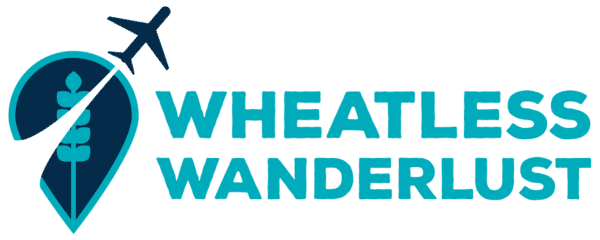
Hello,
Thank you very much for this guide 🙂
I will be visiting San Francisco at the beginning of this August, and I would like to ask you what I should add if I have five days at my disposal (one more day than the itinerary).
Should I add a visit to Fisherman’s Wharf and a few more neighborhoods? If yes, what should these be?
Hey there Andreas!
I’d actually consider walking across the Golden Gate Bridge into Sausalito, and spending an afternoon over there. You can walk one way (the bridge will likely be foggy, cold, and windy, so bring a jacket!) and take the ferry from Sausalito back to San Francisco (https://www.goldengate.org/ferry/route-schedule/sausalito-san-francisco/).
There are some cool places to eat and drink over there, and the town itself is gorgeous, with colorful houses sprawling up the hillsides.